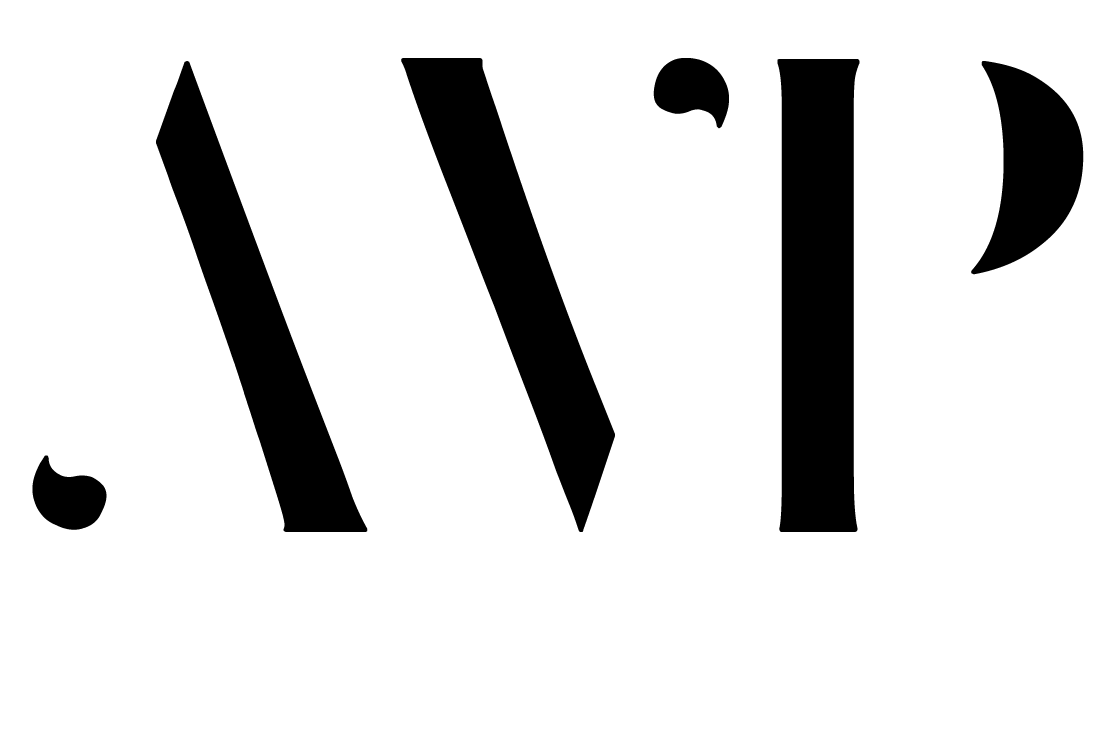ROLE: product designer
Project Brief:
A large part of the Property Management experience is the ability to triage, handle, complete Service Requests. The current communication channels that Darwin uses to engage between its Users (Vendor, Resident and Owner) are disconnected and leads to delays and process inefficiencies across the Operational side of the business. This ultimately affects Residents’ home experience because work is not being completed in a timely manner. There is no doubt that enhancements can be made as they relate to status, progress, transparency and efficiencies in communication channels within the system between all 3 parties.
A large part of the Property Management experience is the ability to triage, handle, complete Service Requests. The current communication channels that Darwin uses to engage between its Users (Vendor, Resident and Owner) are disconnected and leads to delays and process inefficiencies across the Operational side of the business. This ultimately affects Residents’ home experience because work is not being completed in a timely manner. There is no doubt that enhancements can be made as they relate to status, progress, transparency and efficiencies in communication channels within the system between all 3 parties.
Please note: That I had ownership of the software user experience starting AFTER intake - everything internal. Another pod was tasked with integrating a third party tool (chatbot) intended to handle data intake.
discovery & Problem assessment
Audit of Current Experience - The Before
Darwin's service request (SR) experience materially impacts Darwin’s ability to be successful which is why it was crucial to give it attention. product did some research to assess the magnitude and shortcomings of this experience:
1. Darwin Brand reputation
3.7, Trustpilot, 1.4 BBB, Google Reviews
75% of negative reviews provided by customers reference displeasure to their maintenance experience.
3.7, Trustpilot, 1.4 BBB, Google Reviews
75% of negative reviews provided by customers reference displeasure to their maintenance experience.
2. Darwin Operations (proxy for future other PM operators)
We continue to see our SR volume increase in two ways. Each putting more pressure to be more efficient without sacrificing execution quality.
• LHUM increase drives SR volume
We already have an SLA [Get median, 90th percentile (use python) on time to close out SR]
Not feasible to scale headcount operations in perpetuity to handle increased LHUM
• More homes now need SR. SR/LHUM rate has increased by 38% Q/Q [ .42 → .58]
Even with slowed growth, volume is increasing more rapidly on a per occupied home basis. This puts even more pressure and stress into operator’s system.
The Importance at taking the opportunity to address this project: "If nothing changes, we will see a decrease in Darwin brand equity and operational quality, coupled with increased costs to do business."
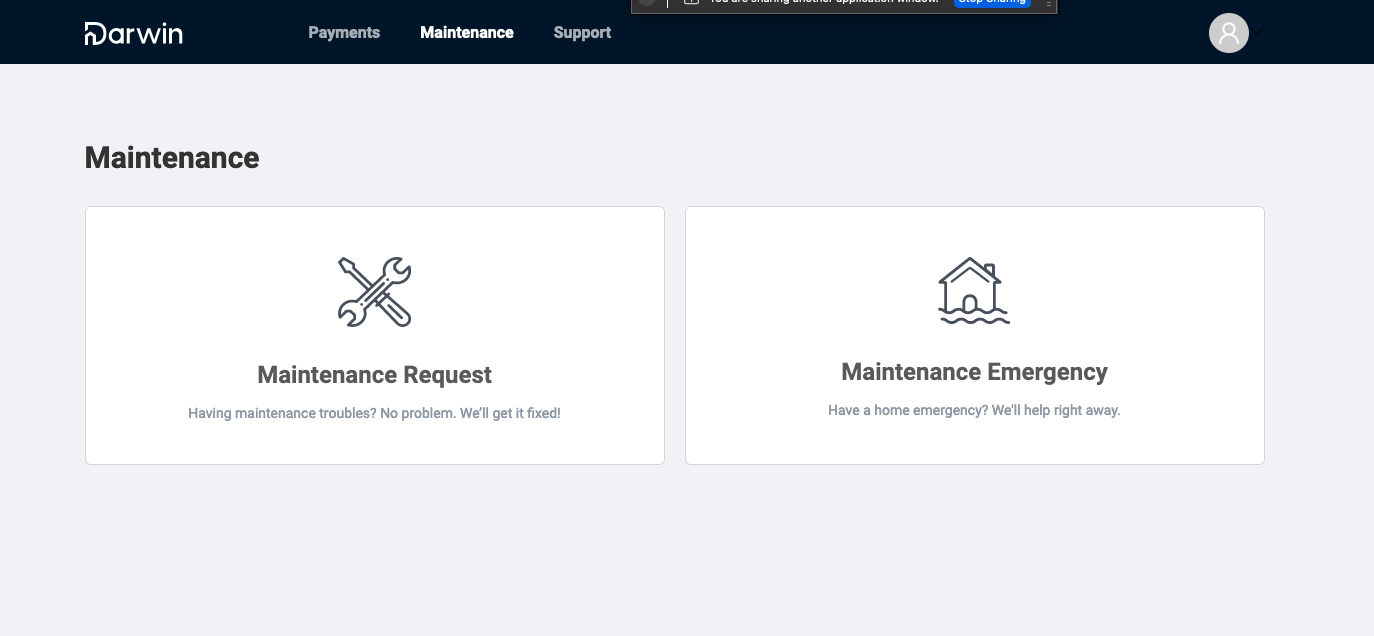
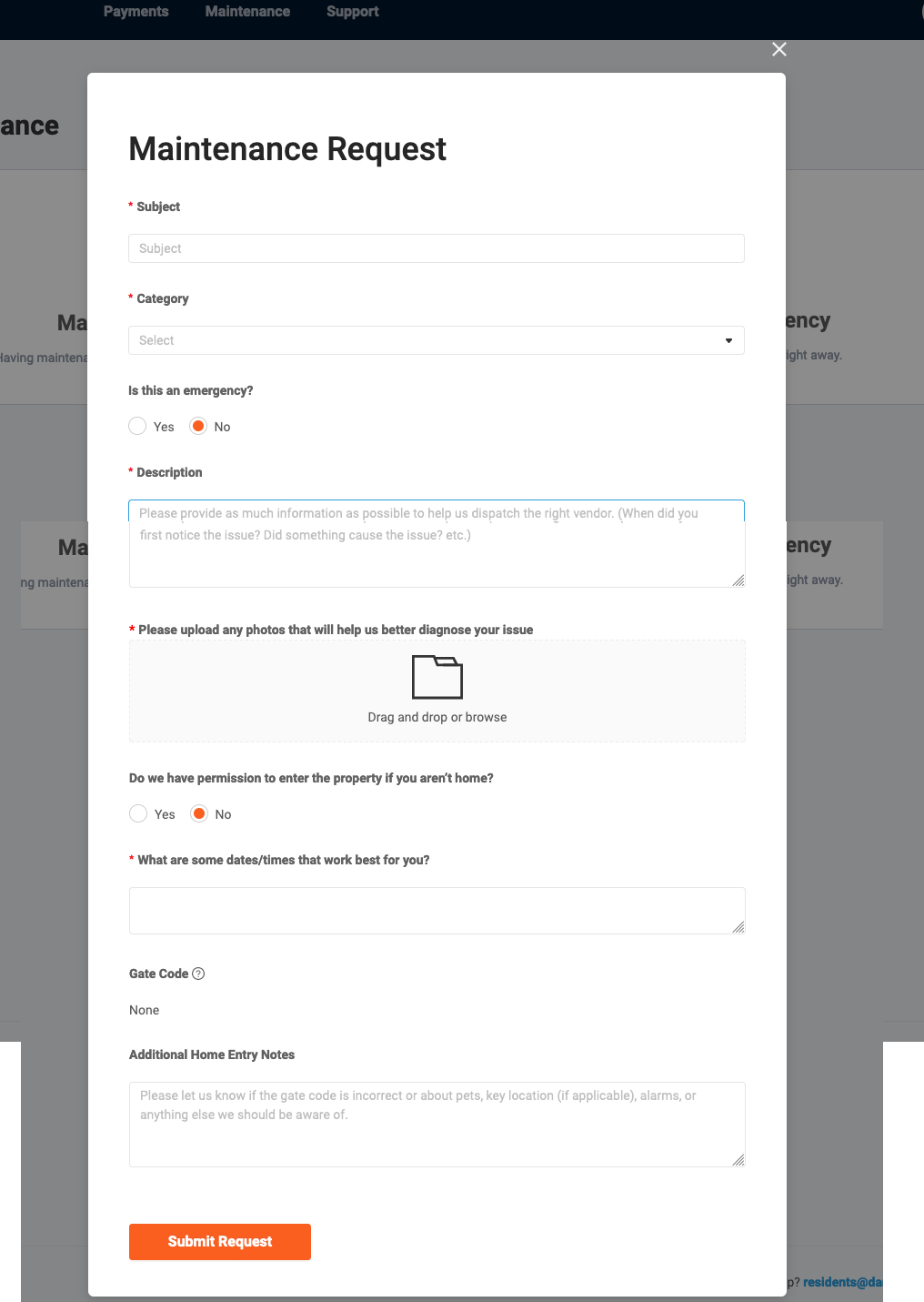

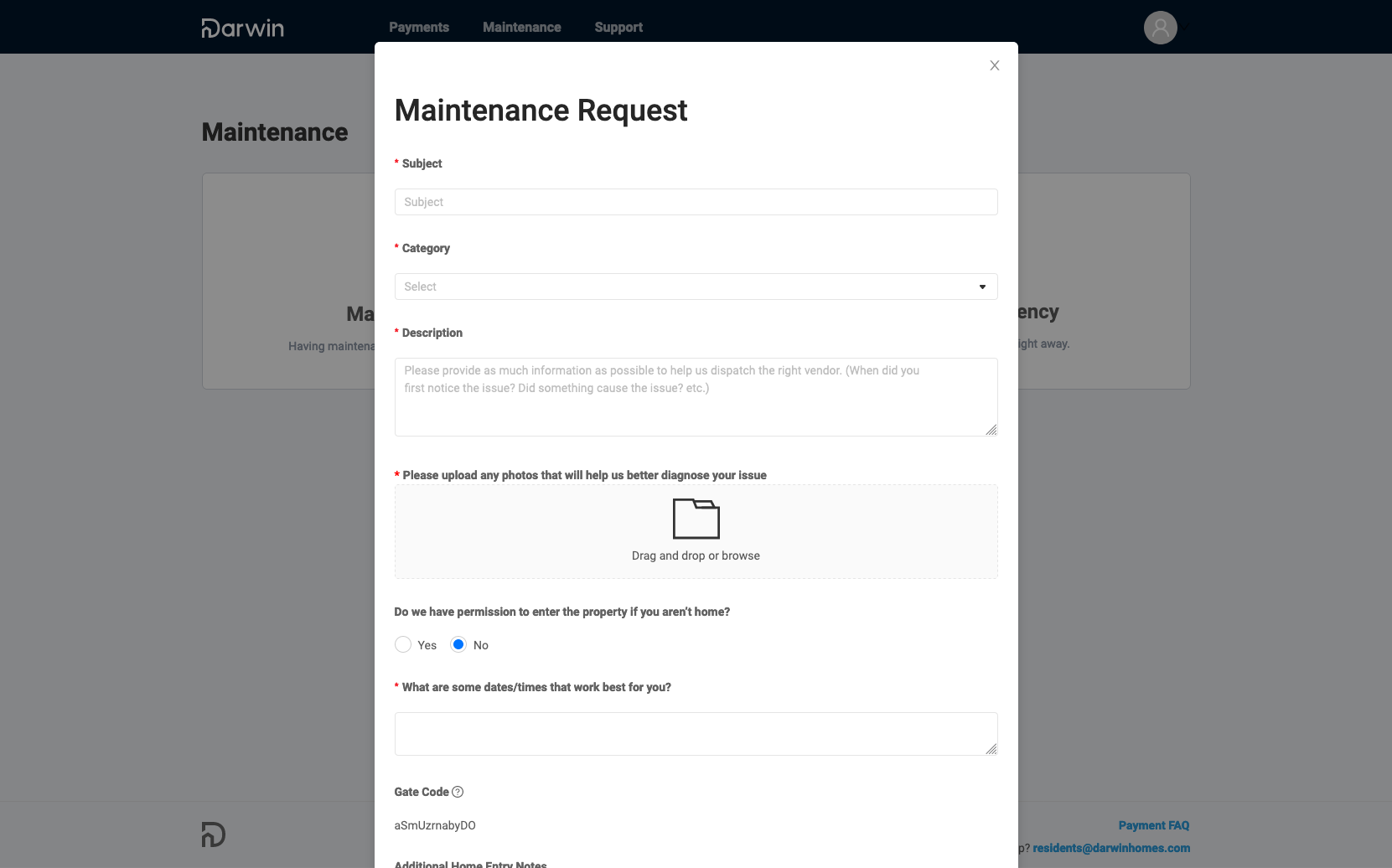
Above: Screenshot of the Residents' Maintenance and portal experience
HEURISTIC Analysis
In the BEFORE designs above:
• Outdated design library UI and elements
• Important emergency information is hidden in a modal
• No confirmation or record of the request submitted to refer to
• Missing questions that paint full picture of the issue or fix
• No scheduling ability or re-scheduling ability
• No on-platform vendor appointment information or history
• No visibility of statuses or progress
• No information on the vendor company coming over to address pic
• Designs are too modal dependent
• Lacks visual hierarchy in fonts and text
• Good use of iconography
• Simplicity through clickable tiles and containers to dictate NEED segmentation (emergency vs non emergency)
• Important emergency information is hidden in a modal
• No confirmation or record of the request submitted to refer to
• Missing questions that paint full picture of the issue or fix
• No scheduling ability or re-scheduling ability
• No on-platform vendor appointment information or history
• No visibility of statuses or progress
• No information on the vendor company coming over to address pic
• Designs are too modal dependent
• Lacks visual hierarchy in fonts and text
• Good use of iconography
• Simplicity through clickable tiles and containers to dictate NEED segmentation (emergency vs non emergency)
"If nothing changes, we will see a decrease in Darwin brand equity and operational quality, coupled with increased costs to do business."
The summary of the current workflow between respective parties:
Operators + Vendors (Ops Process)
Checks in Front or takes a phone call → Responds back to Vendors → Transfer notes to WO Notes section
Vendor’s Process
Emails or calls Darwin → Gathers necessary information → Makes a decision on Vendor PortalI spoke
Operators + Residents
Most comms received from Residents relate to status updates. We’ve recently added email notifications to keep them in the loop for the Service Request that they submitted. However, there is no doubt that we can make enhancements here as they relate to both updates and efficient communication channels within the system.
Full Journey Map audit for documentation was drafted by me and is seen below:
User Flows audit of the full service request journey map (User -facing and internal as well)
Credit: Me (Ana Peralta
Credit: Me (Ana Peralta
Our hypothesis of the problem
How do we ensure Residents/Vendors/Operators are confident that SR is handled and flowing through the process efficiently
1. Vendor can see and obtain relevant information for the
WO throughout the lifecycle
WO throughout the lifecycle
2. Resident can see progress of their service request (SR)
in a meaningful way
in a meaningful way
3. PM Operator knows when to escalate or to intervene
due to inaction by either party
due to inaction by either party
4. Alternatively, it was noticed that work orders are getting
stuck in statuses that require Vendors action (to make a
decision and estimates etc), however, they are often
unable to move forward due to the fact they have
comments, questions and concerns related to the work
order itself.
stuck in statuses that require Vendors action (to make a
decision and estimates etc), however, they are often
unable to move forward due to the fact they have
comments, questions and concerns related to the work
order itself.
If we provide a way for Vendors to comment or ask questions via their Vendor Portal, then they will be able to make faster decisions
If we attempt to keep everything within the system, then the effort won’t be spent on staying organized (by transferring notes around), rather it will be spent more on moving things forward which requires the utmost attention.
Why should we solve it?
Centralized place within the WO object with notes and conversations
Healthy ecosystem between different platforms (Origin and Vendor Portal)
Easier reminder mechanism within the system for PM Ops
Pod Game plan: Proposed Approach and areas of improvement
My pod was in charge of addressing: Improved visibility and transparency of Service request (SR) and Work Order (WO) Details and Progress. Through a pod workshop (between Product Manager, UX Lead -me- and Engineer Lead) we agreed this effort will be a combination of data capture and surfacing, clear, actionable, with SLA, status of a work order (WO) throughout (may need to update our current understanding and usage of status).
The more that we can improve the up-funnel (front-facing) experience, the more likely we have outsized positive outcomes across the entire experience.
1. Primary Focus
Improved visibility and transparency of SR Details and Progress
How and where do we expose SR updates that can be easily understood just by taking a quick glance (Action needed from me? Who are we waiting for? Is the finish line in sight?)
• Resident - How do we keep the Resident happy throughout this SR process?
* [Proactiveness] Provide as many meaningful updates as possible
* This should reduce the frustration and urge to find out where things are at
* Similar to ordering something online - If something is not going as expected, we would expect some kind of
update to notify us of the delay(s)
* [Accountability] Vendor shows up on the initial scheduled start date
* This should provide peace of mind for the Resident, knowing that we work with the most reliable and best
• Vendors
* Today, there are a lot of reschedules. While that might be on the Vendor, rescheduling immediately loses the
trust of the Resident (we’re walking on a very tight rope here)
* Vendor How do we keep the Vendor happy throughout this SR process?
* Provide a sufficient amount of information as to what work is needed
* Provide an abundant, yet realistic, amount of work
* Clear definition of what WO statuses mean
* Example: Invoice Rejected but we do not let Vendors know the reason why it was rejected, resulting in
frustration because they’re not getting paid (potentially)
* Problem Breakdown
* Inability to take an action due to insufficient amount of information presented
* All contexts are not in one single spot, especially comms
* Lack of reminders when WOs are past the due date (today = 8/24)

• Operator/Owner - How do we keep the Operator happy throughout this SR progress?
* A clear list of SRs that requires my attention daily (new, stale, etc.)
* Being able to see what’s been closed out on any given day
Improved visibility and transparency of SR Details and Progress
How and where do we expose SR updates that can be easily understood just by taking a quick glance (Action needed from me? Who are we waiting for? Is the finish line in sight?)
• Resident - How do we keep the Resident happy throughout this SR process?
* [Proactiveness] Provide as many meaningful updates as possible
* This should reduce the frustration and urge to find out where things are at
* Similar to ordering something online - If something is not going as expected, we would expect some kind of
update to notify us of the delay(s)
* [Accountability] Vendor shows up on the initial scheduled start date
* This should provide peace of mind for the Resident, knowing that we work with the most reliable and best
• Vendors
* Today, there are a lot of reschedules. While that might be on the Vendor, rescheduling immediately loses the
trust of the Resident (we’re walking on a very tight rope here)
* Vendor How do we keep the Vendor happy throughout this SR process?
* Provide a sufficient amount of information as to what work is needed
* Provide an abundant, yet realistic, amount of work
* Clear definition of what WO statuses mean
* Example: Invoice Rejected but we do not let Vendors know the reason why it was rejected, resulting in
frustration because they’re not getting paid (potentially)
* Problem Breakdown
* Inability to take an action due to insufficient amount of information presented
* All contexts are not in one single spot, especially comms
* Lack of reminders when WOs are past the due date (today = 8/24)

• Operator/Owner - How do we keep the Operator happy throughout this SR progress?
* A clear list of SRs that requires my attention daily (new, stale, etc.)
* Being able to see what’s been closed out on any given day
Research
Teaming with the Product Manager and Lead Engineer, the 3 of us made data requests and from different perspectives and dates to get a picture of what the system is capturing. We also participated in a Vendors Roundtable where we interviewed Vendor partners in our property management network and documented first-hand feedback and info.
Methods Used:
• Attitudinal: User Interviews in the form of a Vendor Roundtable session
• Data: Historical quantitative data from the software
Research Data Insights and Findings
• Service Request Work Orders that require external decisions/actions take 2nd, 3rd, and 4th place in terms of
volume
• 428 of 1,111 outstanding work orders as of 8/24/22 (38.5%)
• On average, Work Orders get stuck in Pending Schedule for close to 6 days. Usually, this is because Vendors are unable to contact Residents to confirm availability, and therefore, they reach out to Darwin for guidance but the channel of communication slows down the process (note: SLA for non-emergency Work Orders is 7-10 days for work to be completed)
• External decisions/actions might potentially be out of our
control but currently, there isn’t a good reminder system for
both internal (PM Ops) and external (Vendors) parties.
volume
• 428 of 1,111 outstanding work orders as of 8/24/22 (38.5%)
• On average, Work Orders get stuck in Pending Schedule for close to 6 days. Usually, this is because Vendors are unable to contact Residents to confirm availability, and therefore, they reach out to Darwin for guidance but the channel of communication slows down the process (note: SLA for non-emergency Work Orders is 7-10 days for work to be completed)
• External decisions/actions might potentially be out of our
control but currently, there isn’t a good reminder system for
both internal (PM Ops) and external (Vendors) parties.
• Implementing a better scheduling tool could potentially help Vendors make faster decisions but that doesn’t necessarily eliminate questions altogether, which is why one of the core problems to solve is the ability to communicate efficiently. In addition, through Mezo’s integration, there will be a lightweight version of a “better scheduling tool” that we can stress test with.
Metrics presented at design sprint kickoff
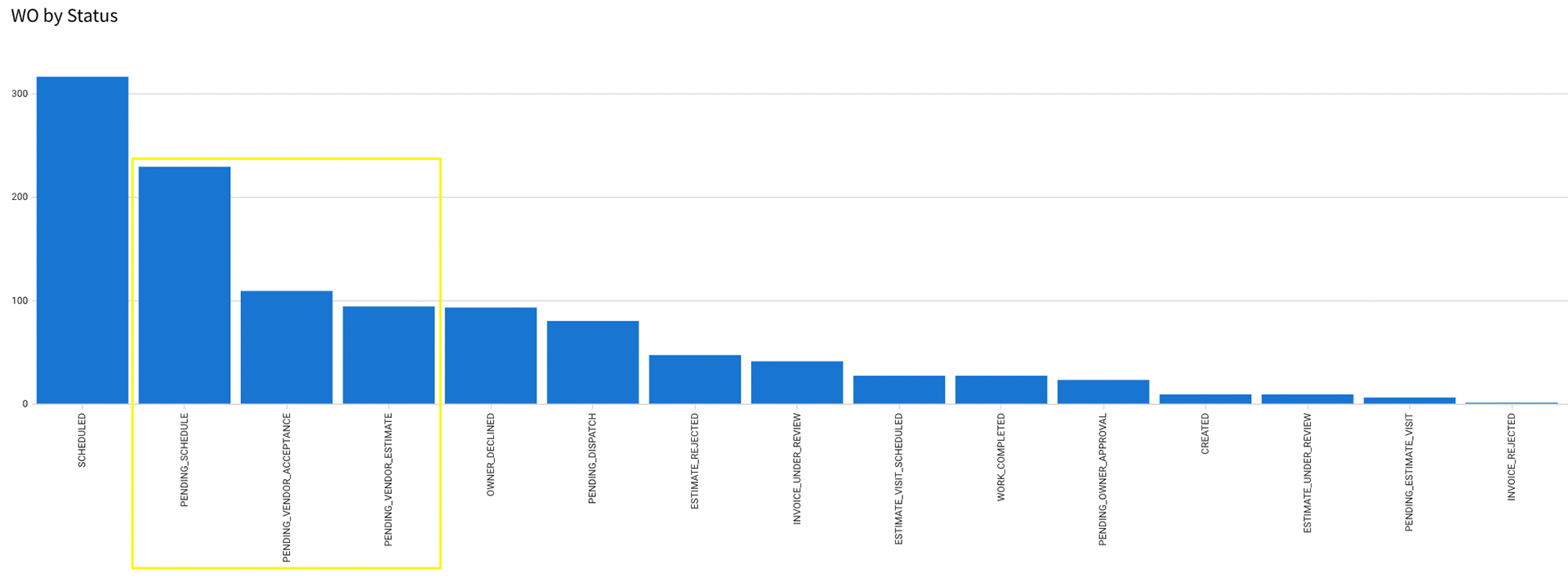
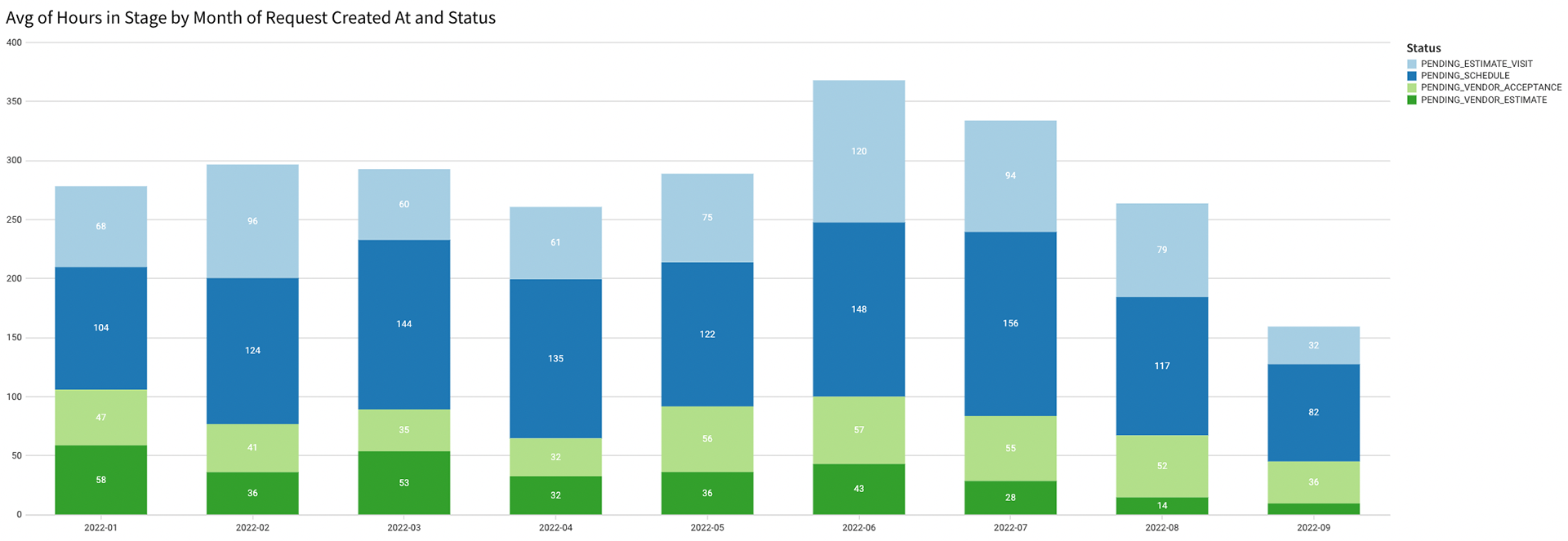
Defined KPIs and metrics
As define by Product manager
As define by Product manager
Vendor Roundtable
User collected Feedback and Pain points
User collected Feedback and Pain points
Residents
As a resident, when I have an issue in my home, I need the ability to inform my property manager so they can fix it.
As a resident, when I have an issue in my home, I need the ability to inform my property manager so they can fix it.
"I want my problem to be fixed"
"I want submitting an SR to be easy"
"I want submitting an SR to be easy"
Darwin Operators
As a property management operator, when I have enough information to diagnose a resident’s issue, I can confidently and efficiently dispatch it to the best vendor to fix it
As a property management operator, when I have enough information to diagnose a resident’s issue, I can confidently and efficiently dispatch it to the best vendor to fix it
"I want SLAs so I know how fast and when to step in"
"I want detailed info from residents to pass to vendors"
"I want to do as little middleman management as possible"
"I want detailed info from residents to pass to vendors"
"I want to do as little middleman management as possible"
Vendors
As a vendor, I feel they I not have enough information to initially diagnose the issue (e.g. categories, photos, and clear descriptions)
As a vendor, I feel they I not have enough information to initially diagnose the issue (e.g. categories, photos, and clear descriptions)
"I want detailed info so I easily estimate how much work I can take"
"I want to fix it once and not have to take multiple trips to the hardware store"
"I want scheduling with residents to be easy"
"I want to fix it once and not have to take multiple trips to the hardware store"
"I want scheduling with residents to be easy"
Operations Leadership team
"My team and I have clarifying questions all the time but the only way for us to ask those questions is through email or call a 1-800 number”, which is not very motivating."
"My team and I have clarifying questions all the time but the only way for us to ask those questions is through email or call a 1-800 number”, which is not very motivating."
Artifact Above: User mapping insights from Vendor Roundtable interview. The insights here were applied to Persona models
Credit: Ana Peralta (Me)
Credit: Ana Peralta (Me)
Design discovery
Competitive Analysis - PropertyMEld
How does our competition (PropertyMeld) handle this problem?
Features we admired:
• Scheduling between vendors and residents w/o phone call
• Multiple mode of communication (text/email), singular channel (all logged and connected)
• Chat option within each SR
• Mobile friendly
• Upload invoice “on the go”
• Ability to create multiple estimates for a single SR
• Workflow Automation
1. Set SLAs (after 72 hours move back to status, send
reminder)
reminder)
2. Triggers typically are based on a status
• Dashboard of SR performance
https://www.youtube.com/watch?v=KLEOvcpKsrg
https://www.youtube.com/watch?v=nopJkDH21R0
https://propertymeld.zendesk.com/hc/en-us/articles/115005091808-How-to-Submit-a-Meld
https://www.youtube.com/watch?v=KLEOvcpKsrg
https://www.youtube.com/watch?v=nopJkDH21R0
https://propertymeld.zendesk.com/hc/en-us/articles/115005091808-How-to-Submit-a-Meld
• Contains a standard form with categories and photos that is not too different from ours currently
• More extensive category list versus Darwin
• Has scheduling with calendar UI - Darwin does not have this - only has availability input in free-text format
Competitive Analysis - Appfolio
• No categories on submission - Darwin has this
• Triage feature called smart maintenance
• Uses person-to-person chat to triage and categorize issues
• Has scheduling - Darwin does not have this
• Image not required - Darwin requires
• Auto-created WO - Darwin does not
• Can manually select Vendor Trade w/ Vendor suggestions - Darwin does not have this
“There are currently no vendors to suggest. Suggestions will be added based on your prior vendor choices on
previous work orders for this property and nearby properties.”
previous work orders for this property and nearby properties.”
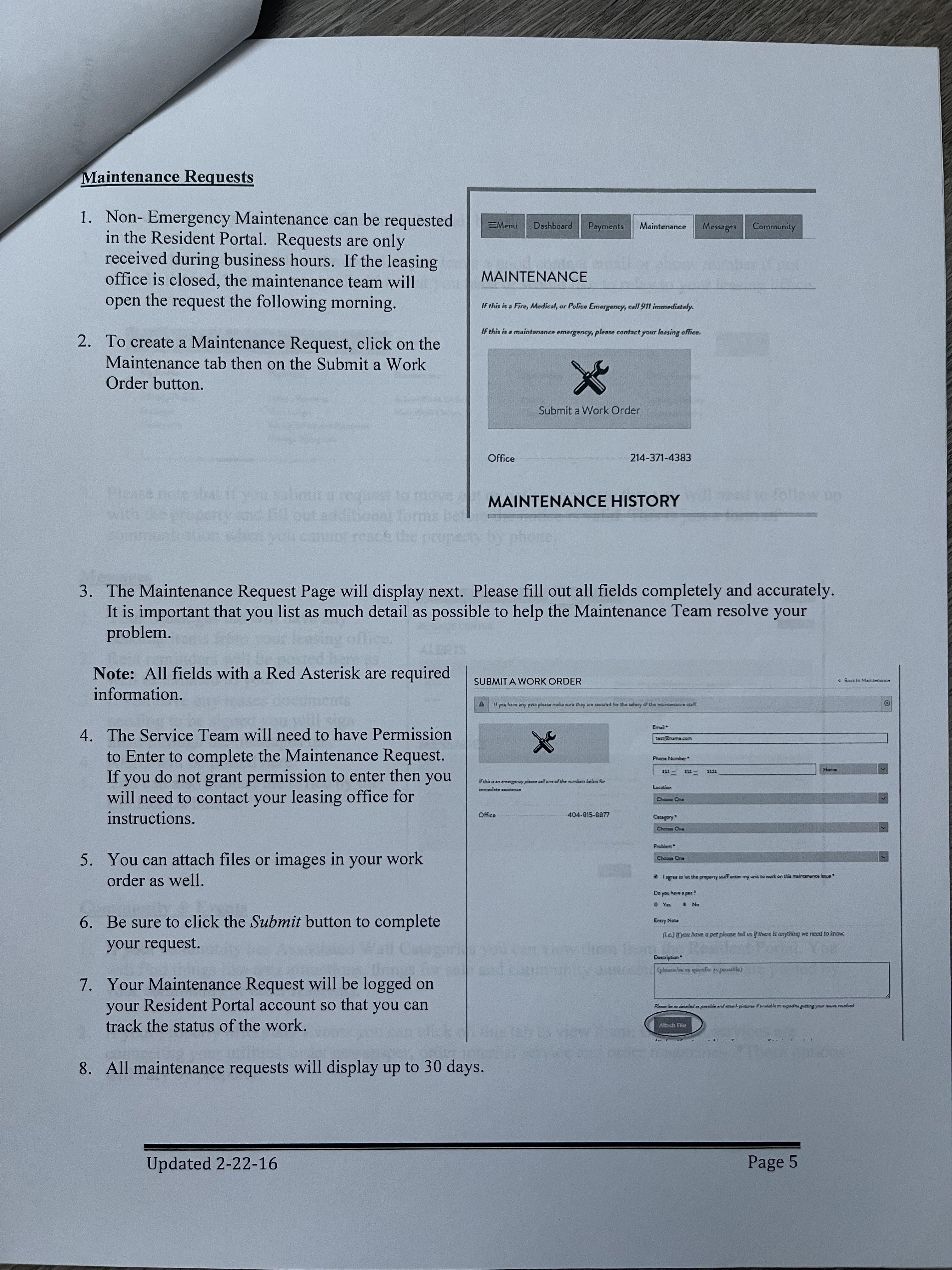
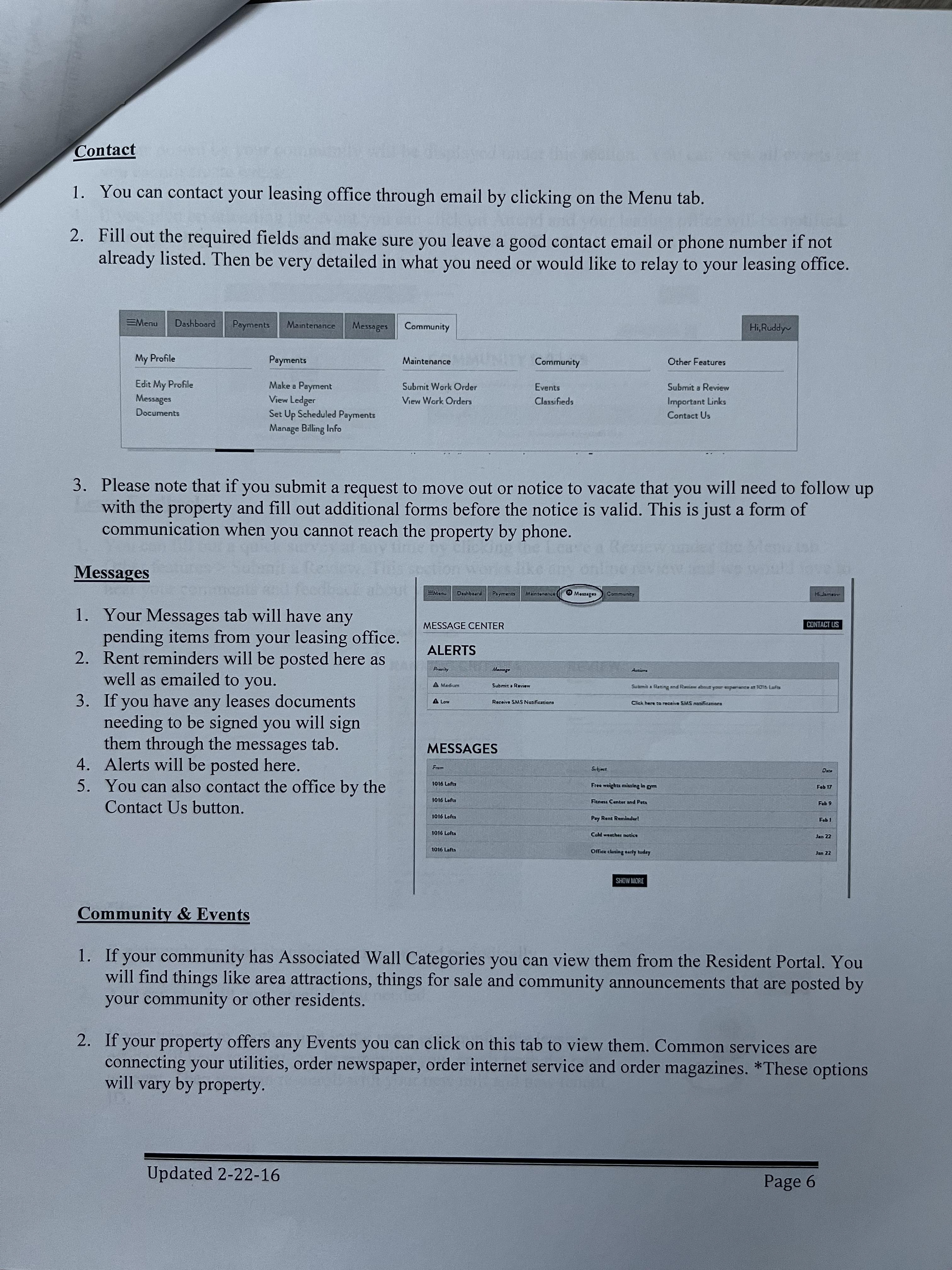
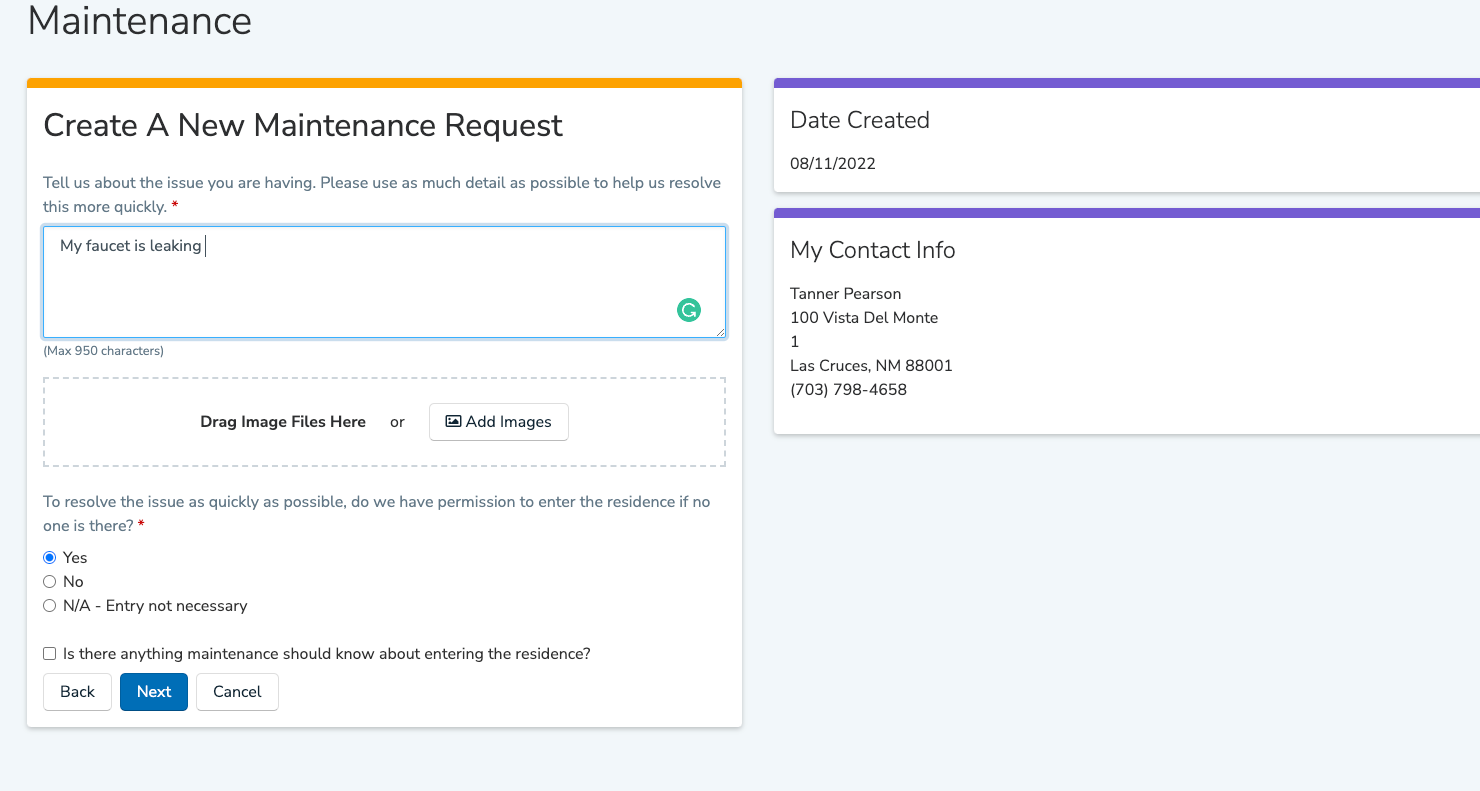
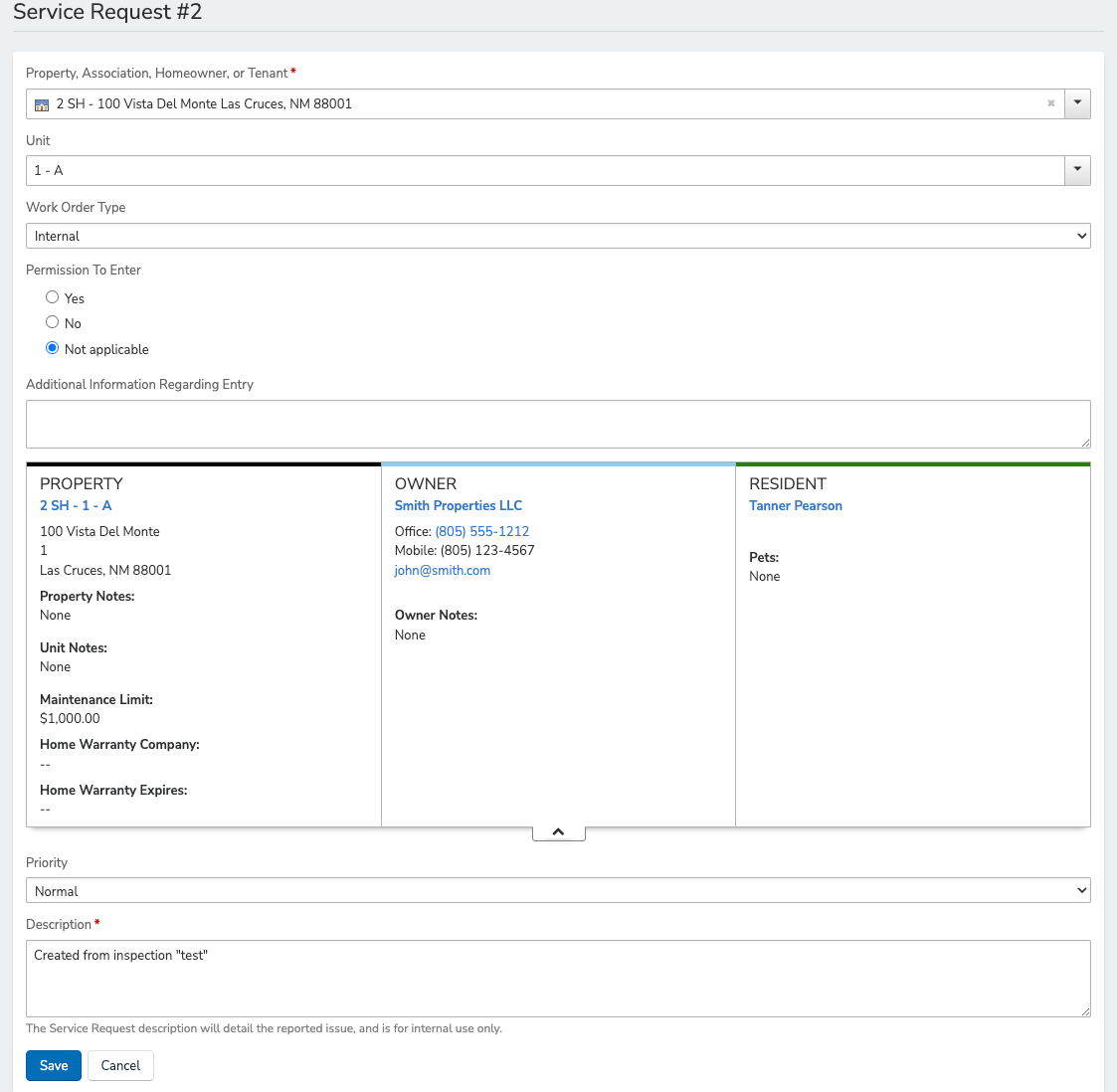


Persona development and user journey studies
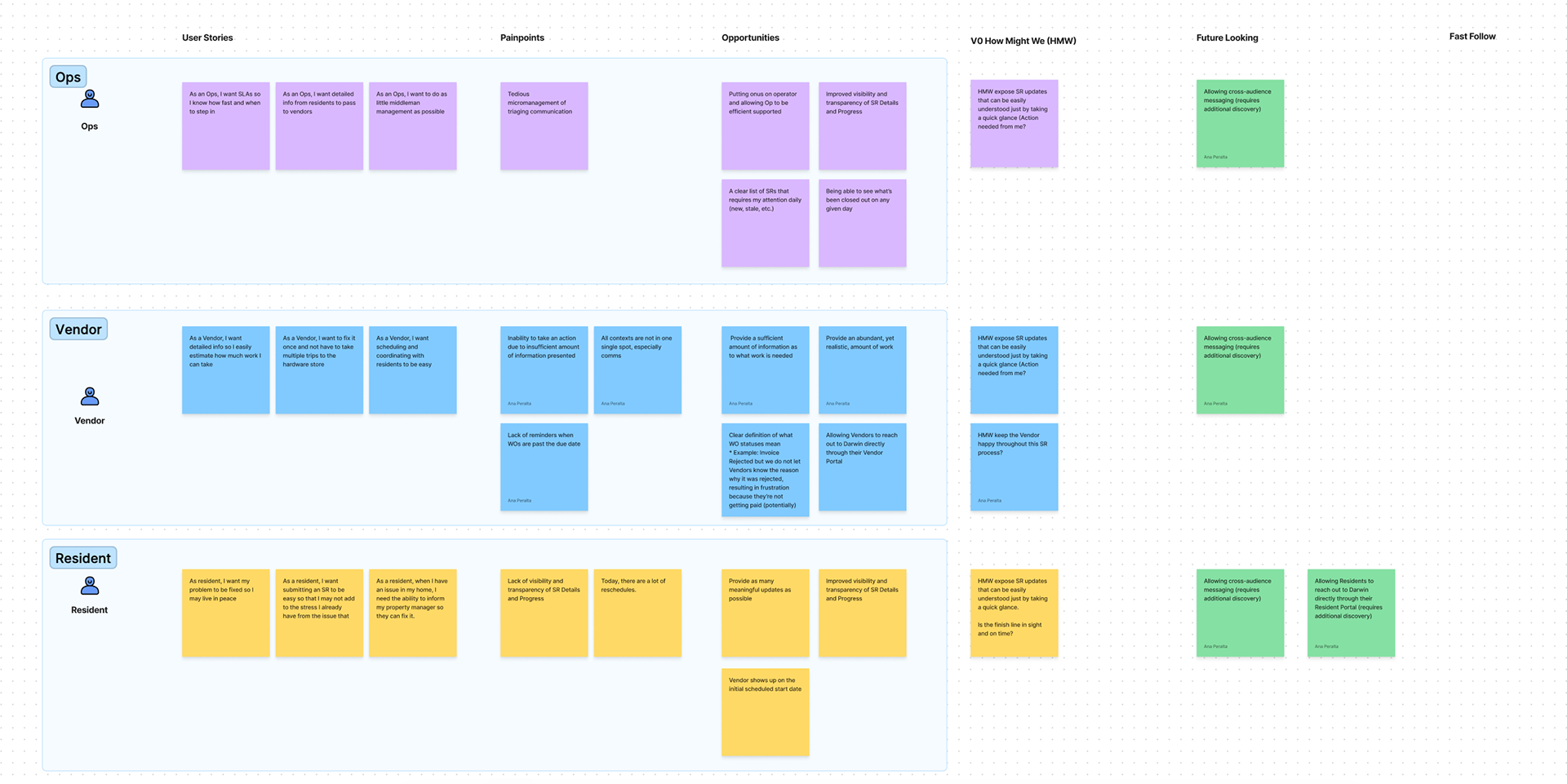
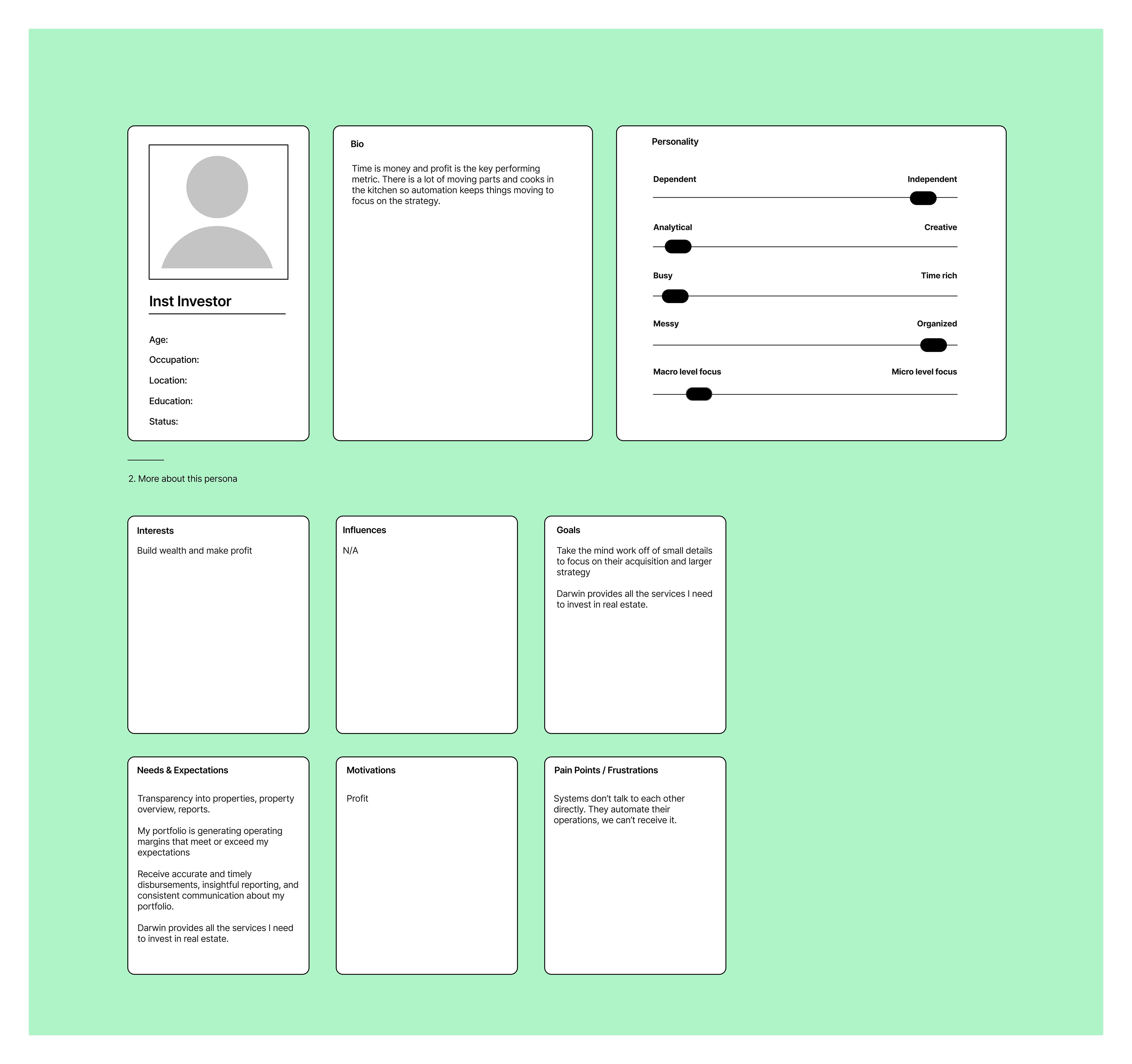
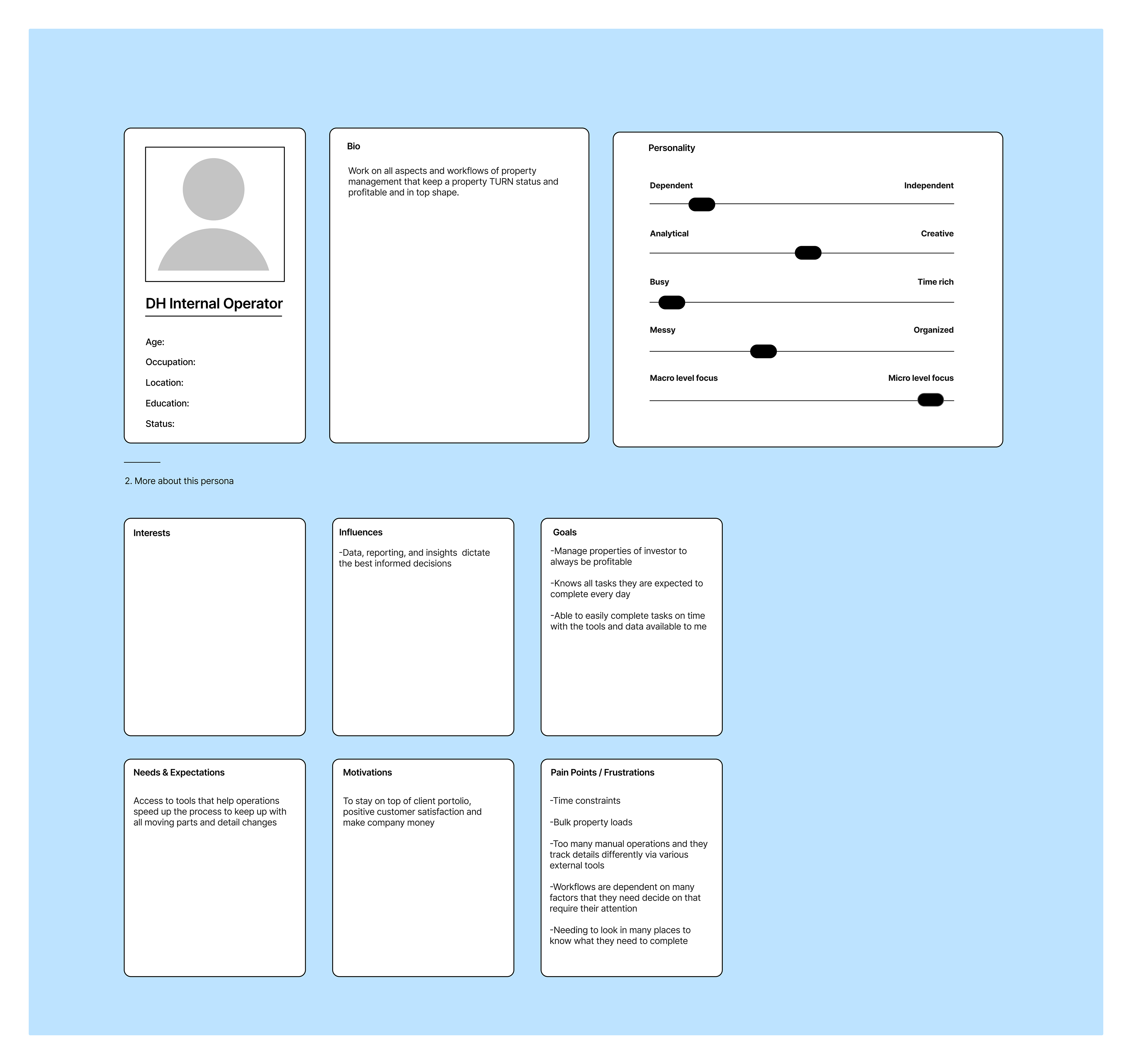
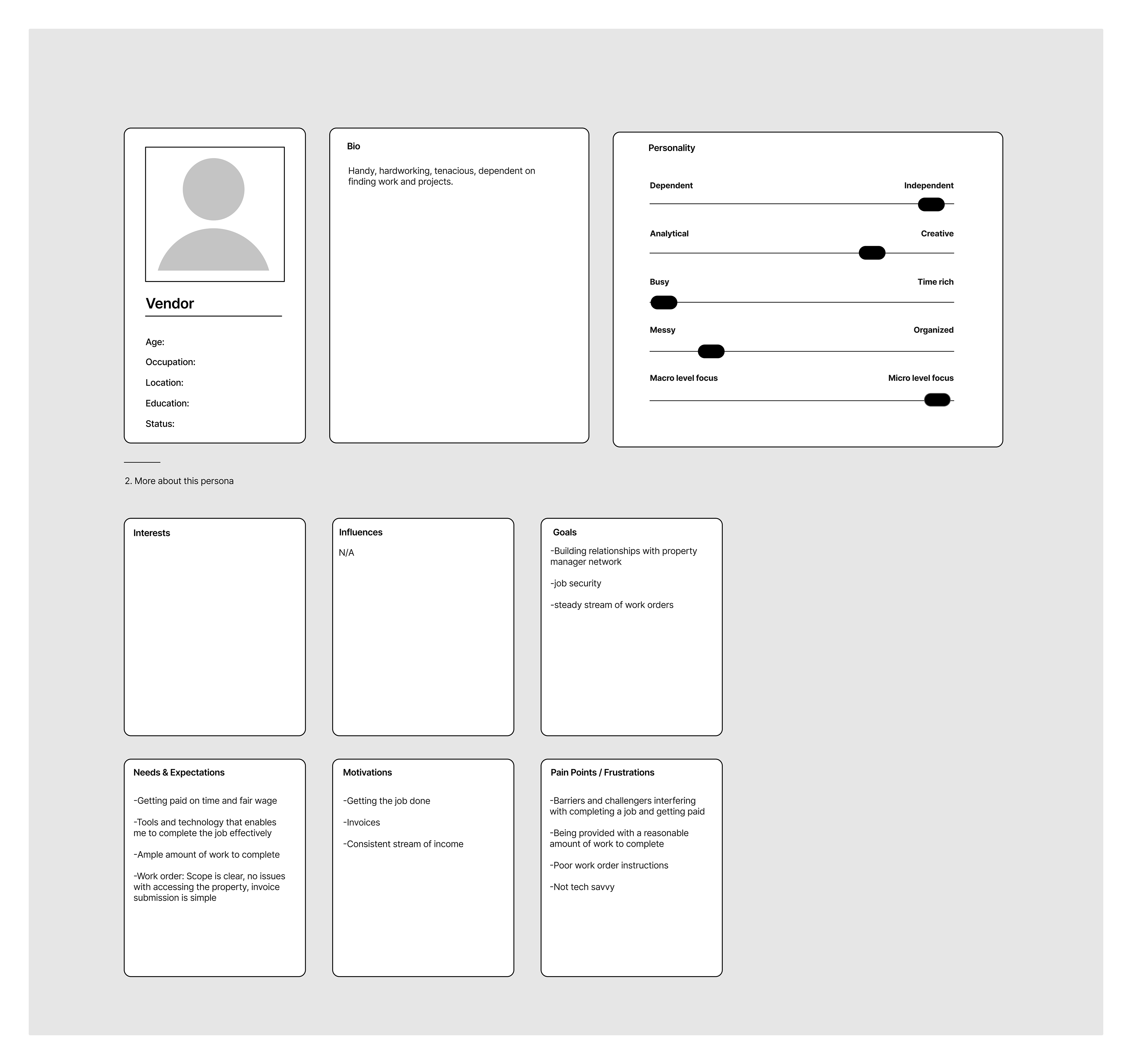
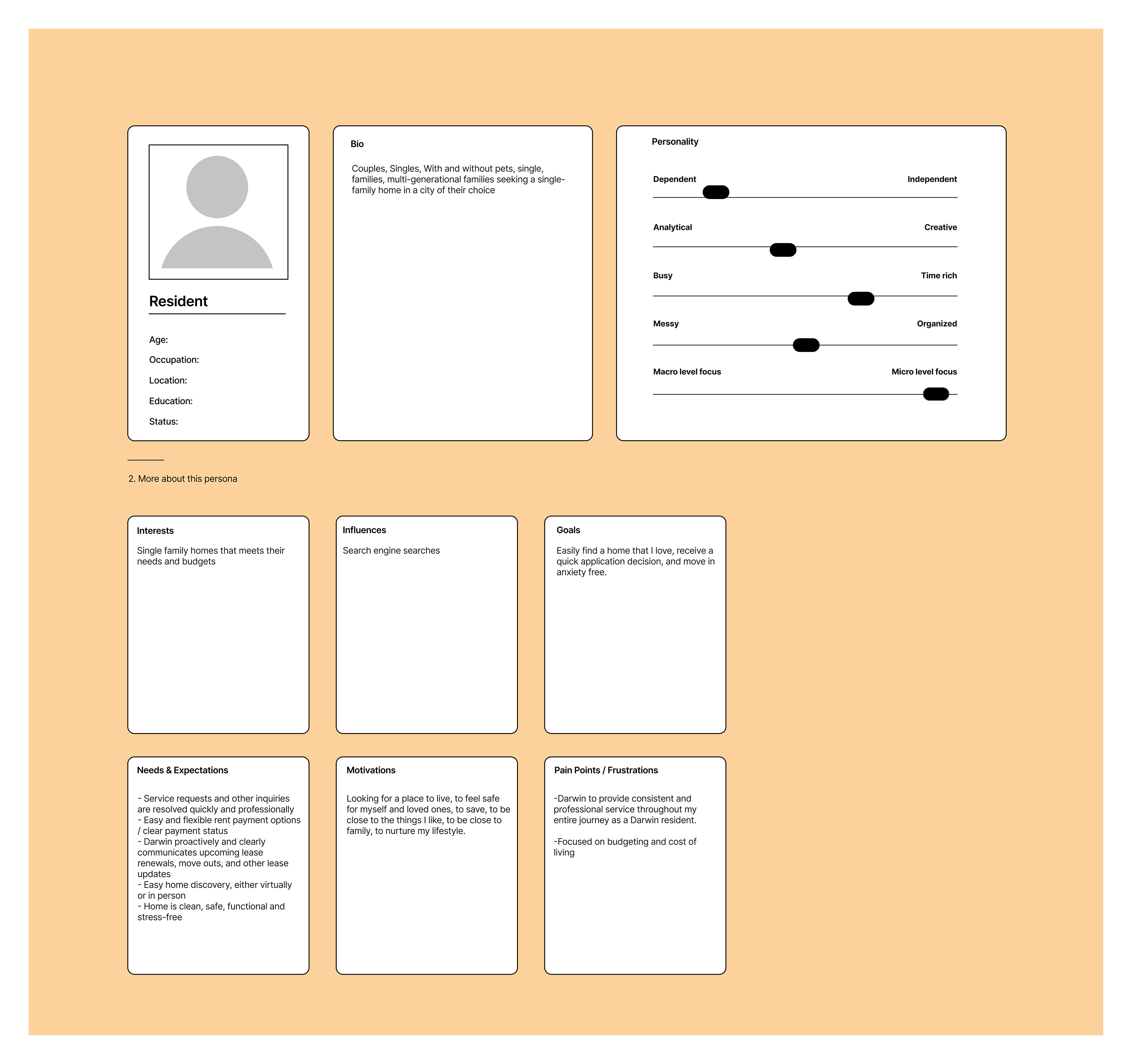
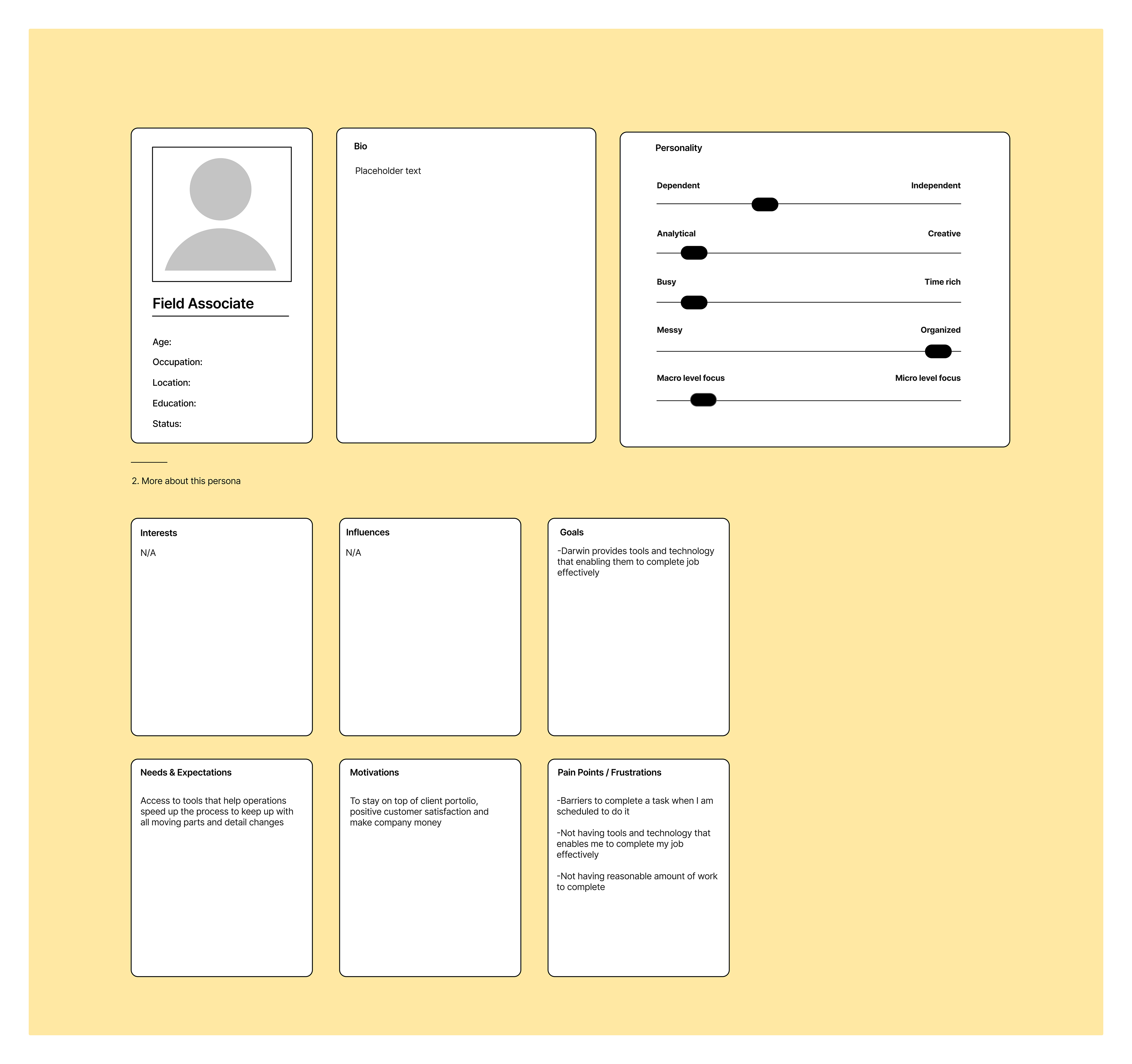
Artifact Above: Persona profiles. The company doesn't currently have Persona models built so I made a quick draft to support design decisions. The insights seen here were sourced from User mapping insights from Vendor Roundtable interview
Credit: Ana Peralta (Me)
Credit: Ana Peralta (Me)
Design and ideation
Design Strategy
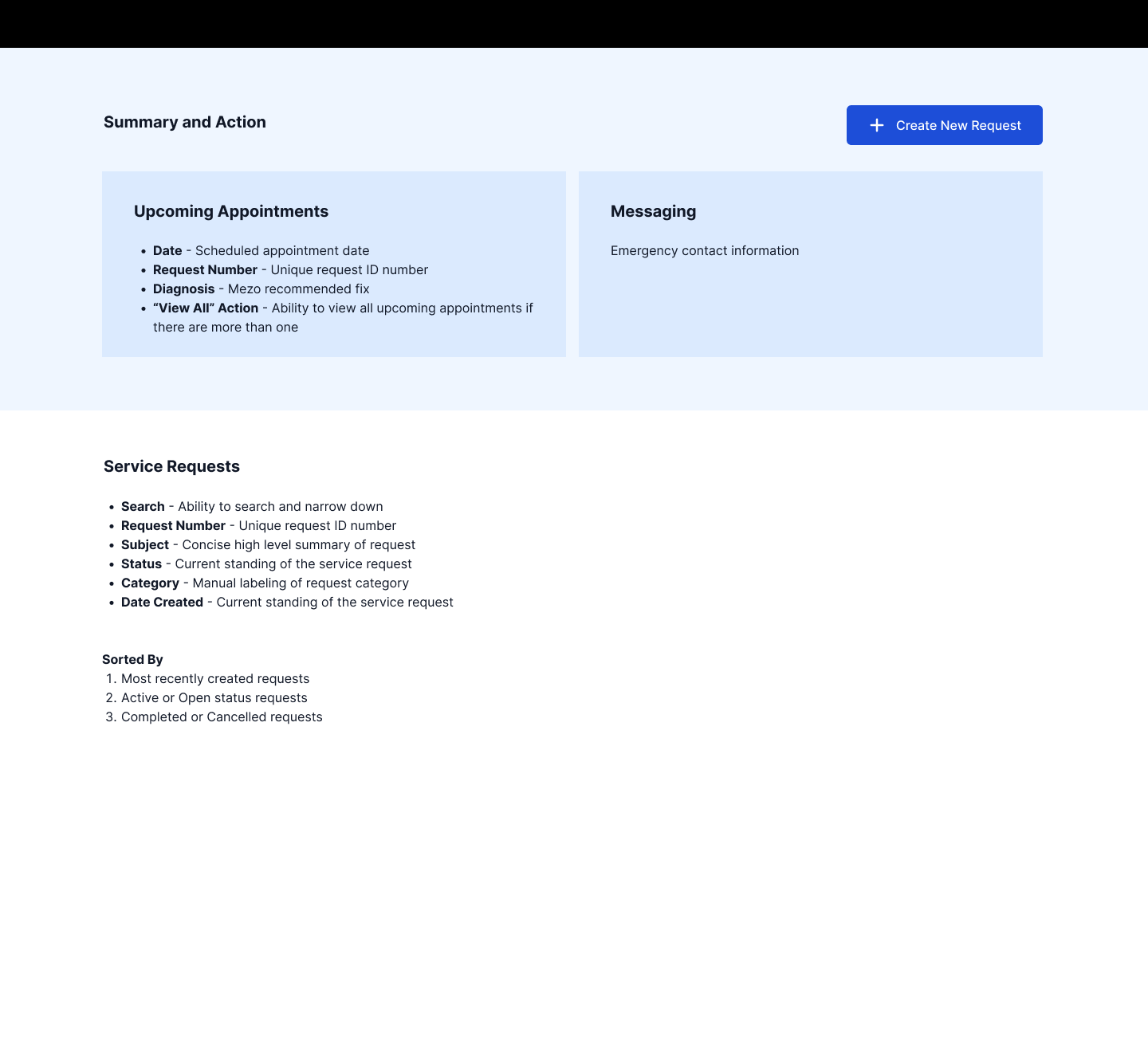
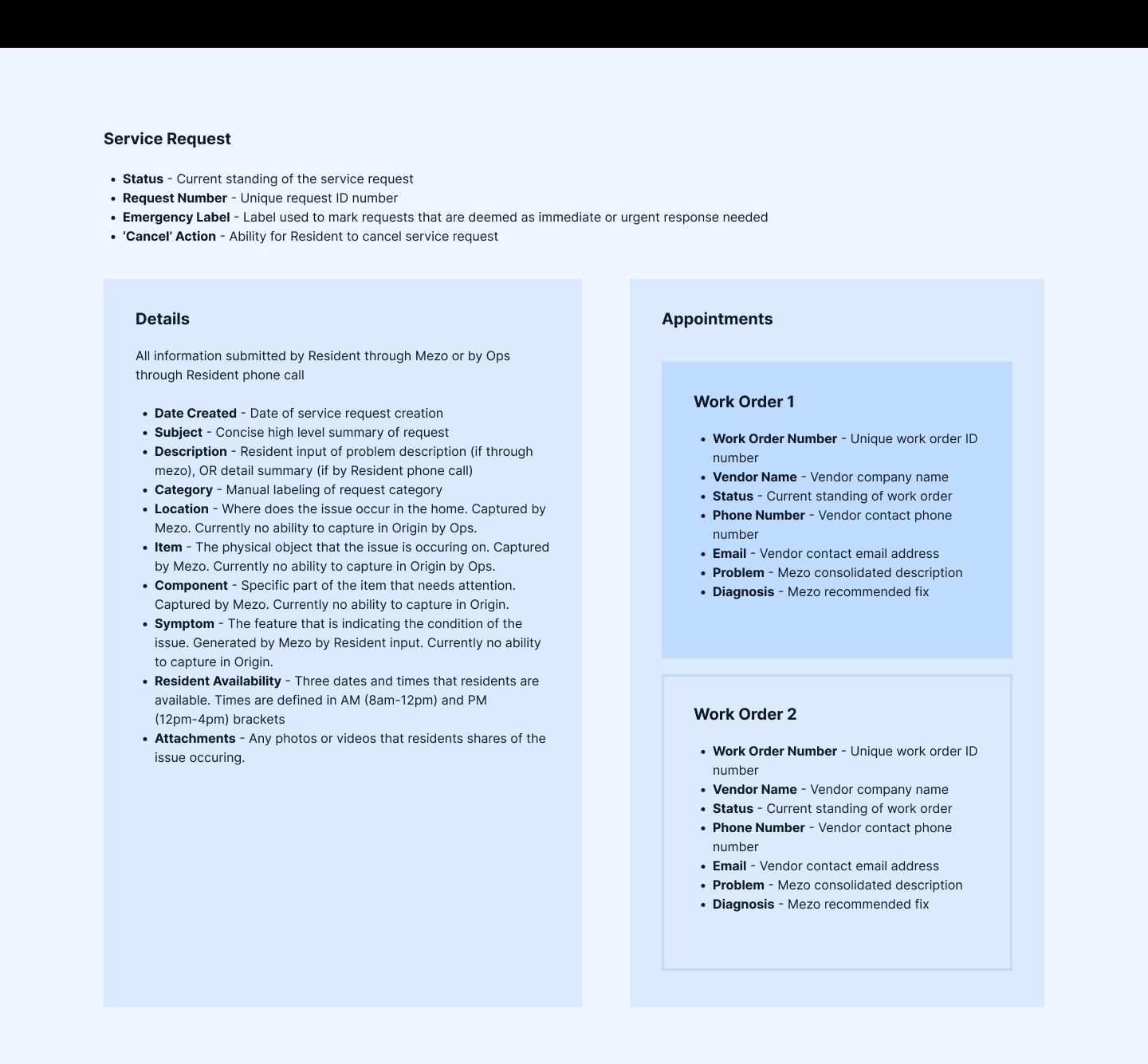
Design Drafts and Iterations
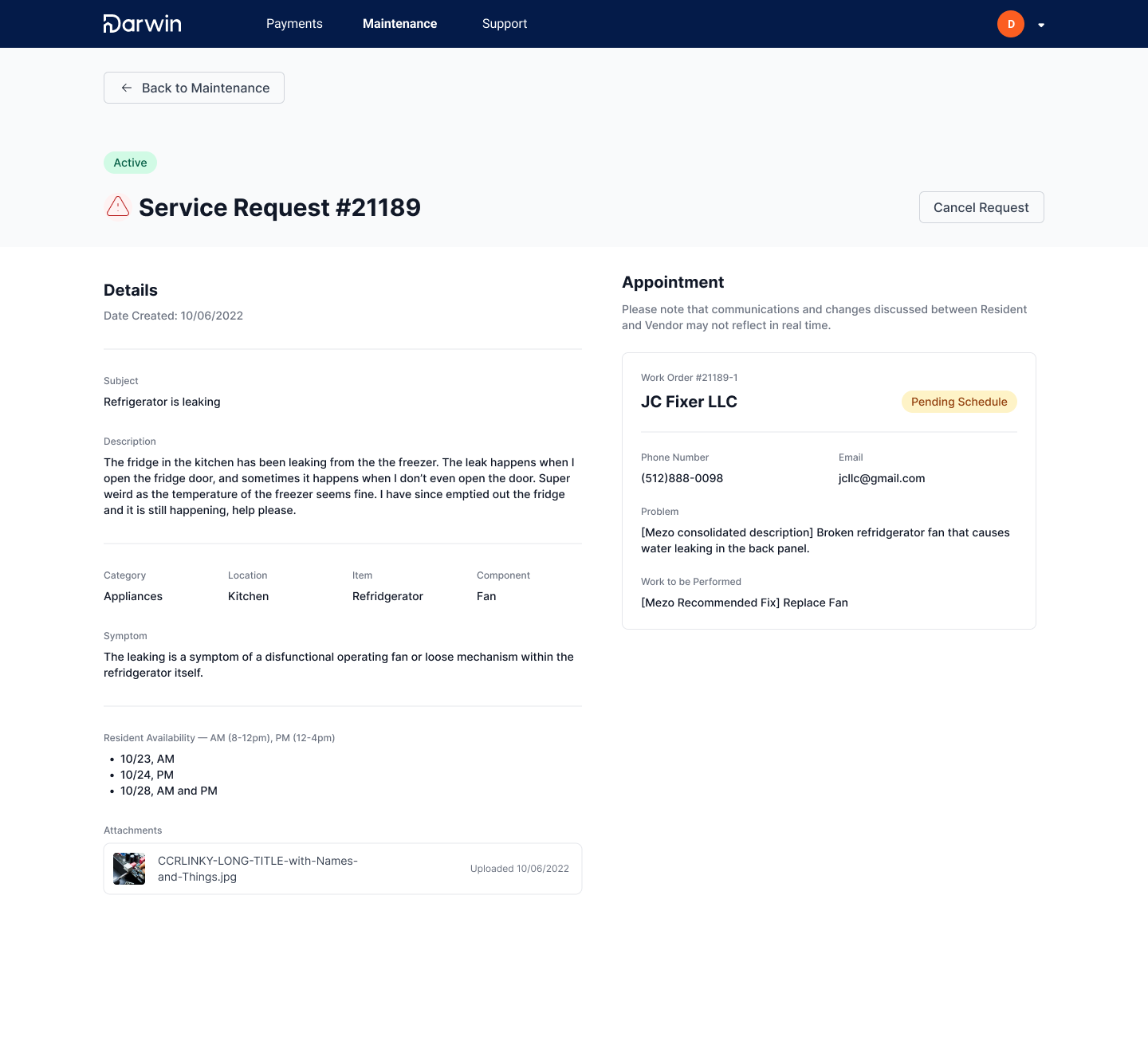

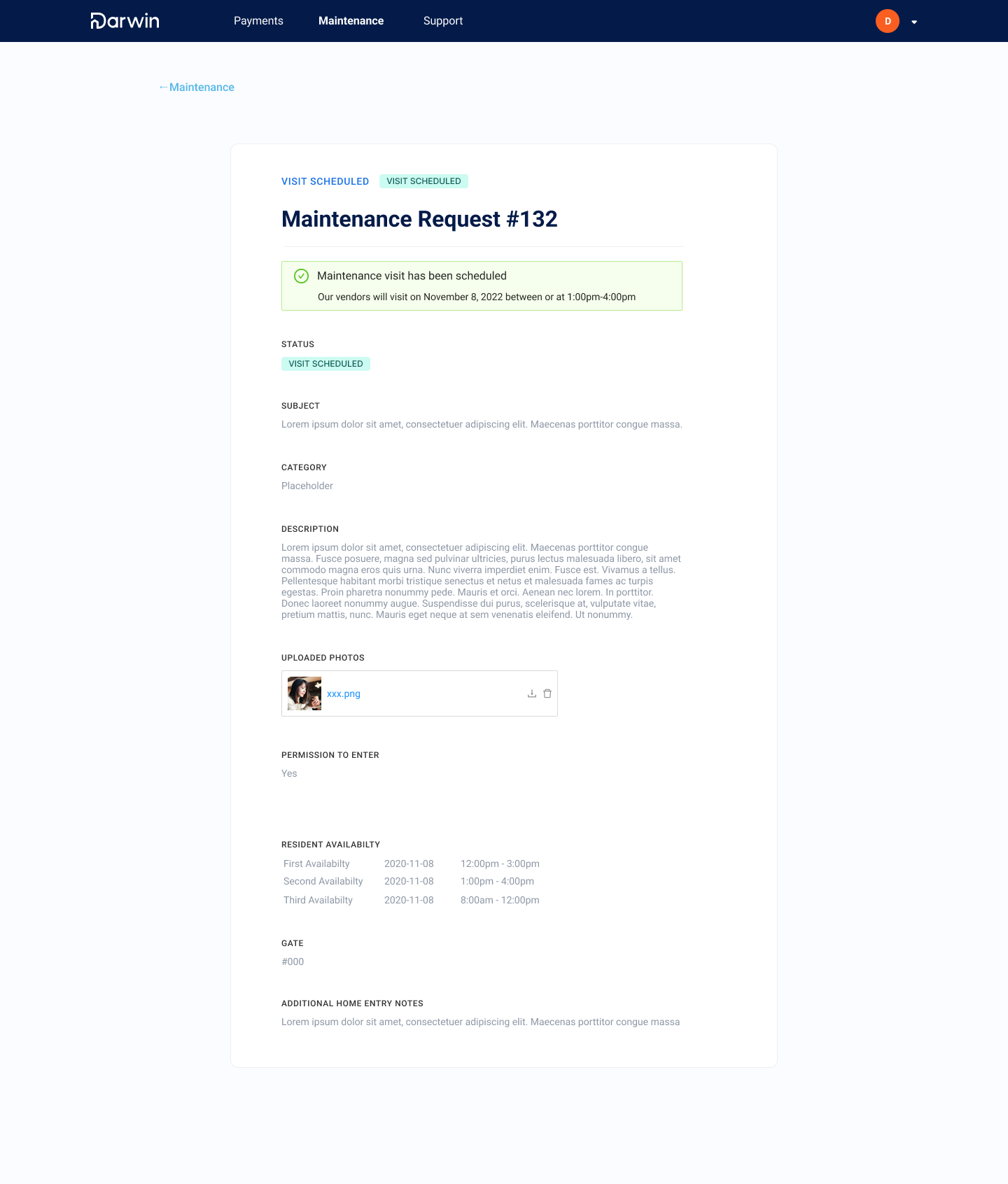
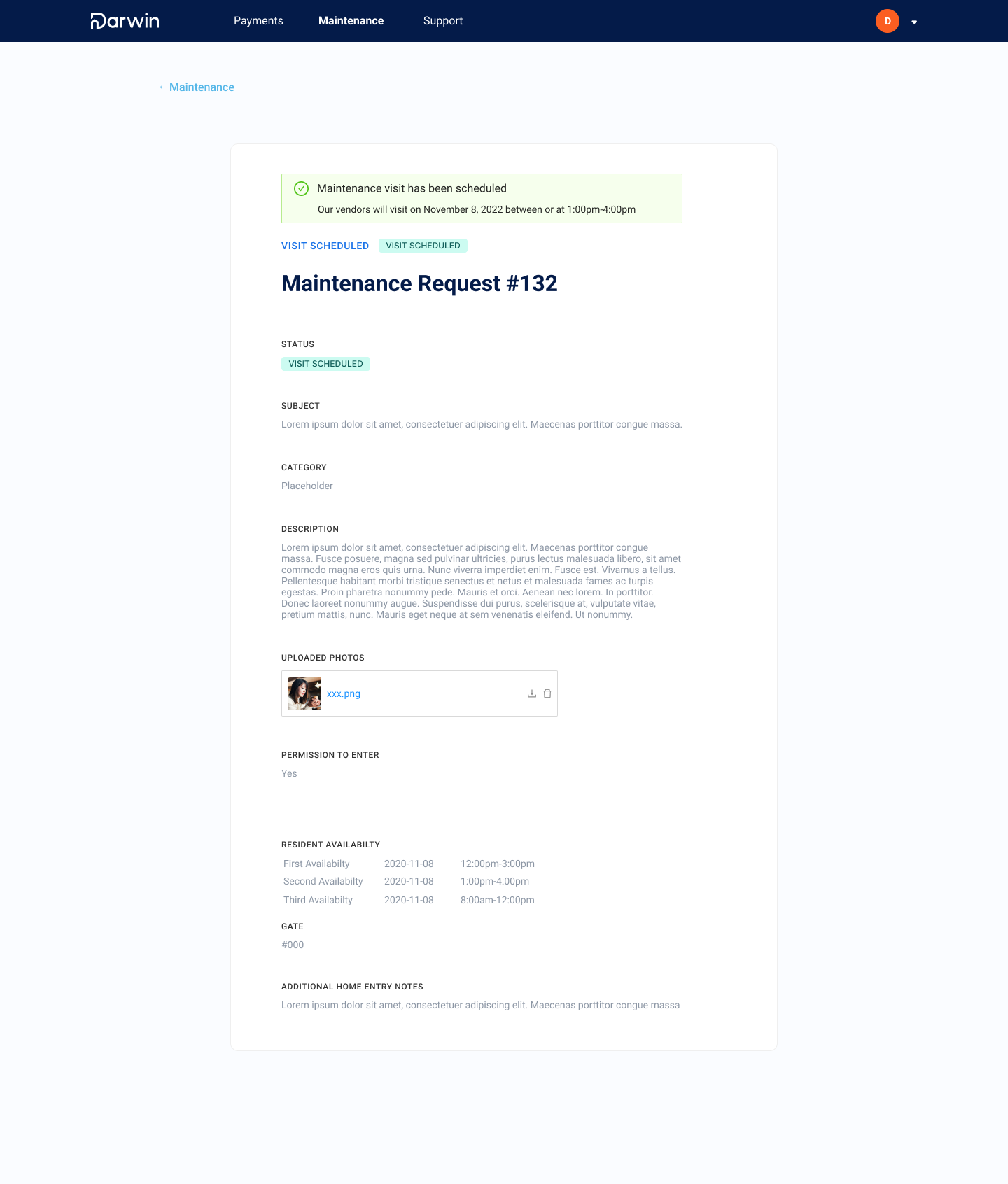
delivered design solutions
Delivered Designs - Desktop
Key Features
• Ability for Residents to understand where in the lifecycle their submitted Service Request is at
• Ability for Residents to quickly understand when the next scheduled appointment is
• Ability for Residents to contact Vendor(s) directly for additional clarification and scheduling
• Ability for Residents to understand where in the lifecycle their submitted Service Request is at
• Ability for Residents to quickly understand when the next scheduled appointment is
• Ability for Residents to contact Vendor(s) directly for additional clarification and scheduling
Delivered Designs - New Maintenance Tab Landing Page & New Appointment Module behavior
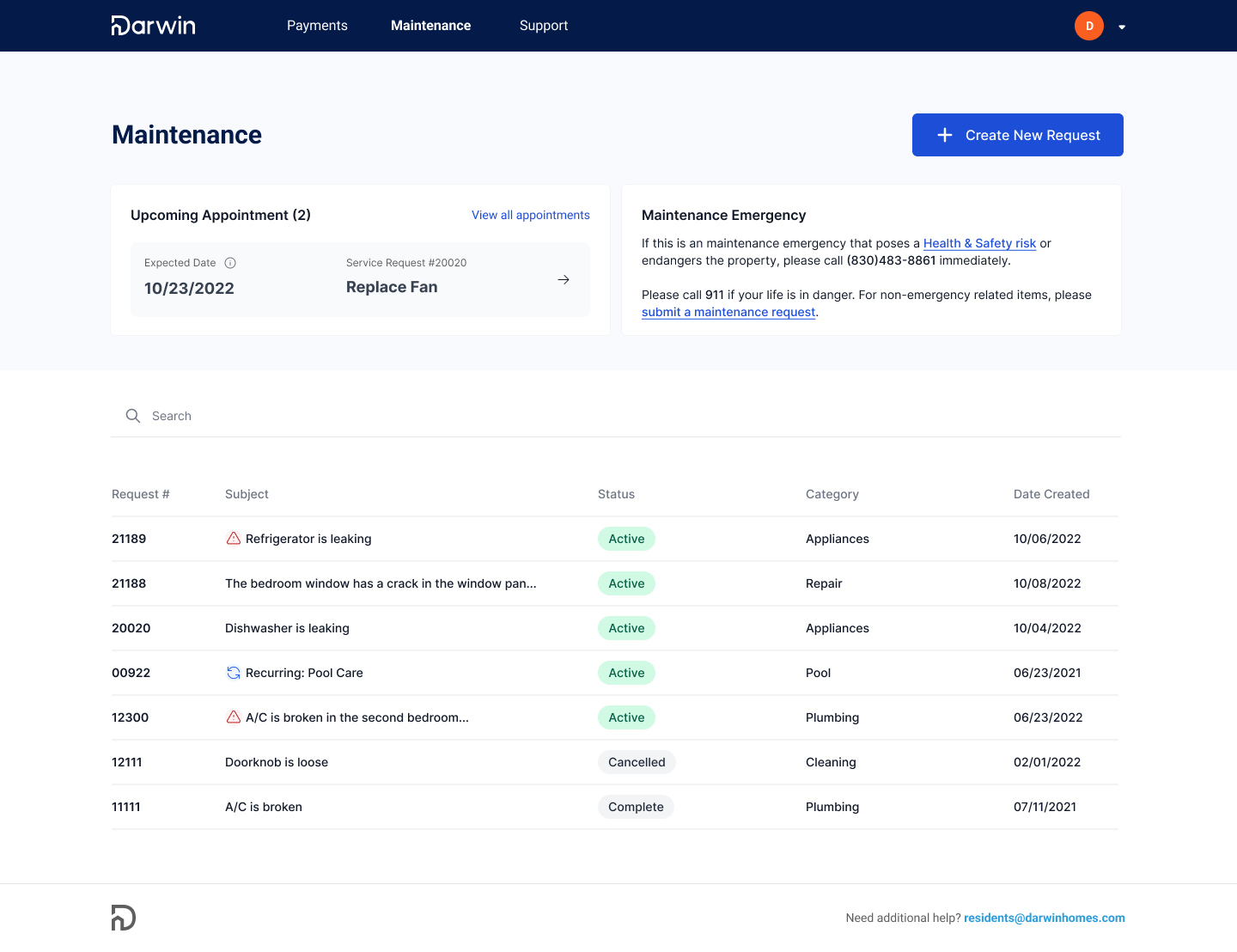
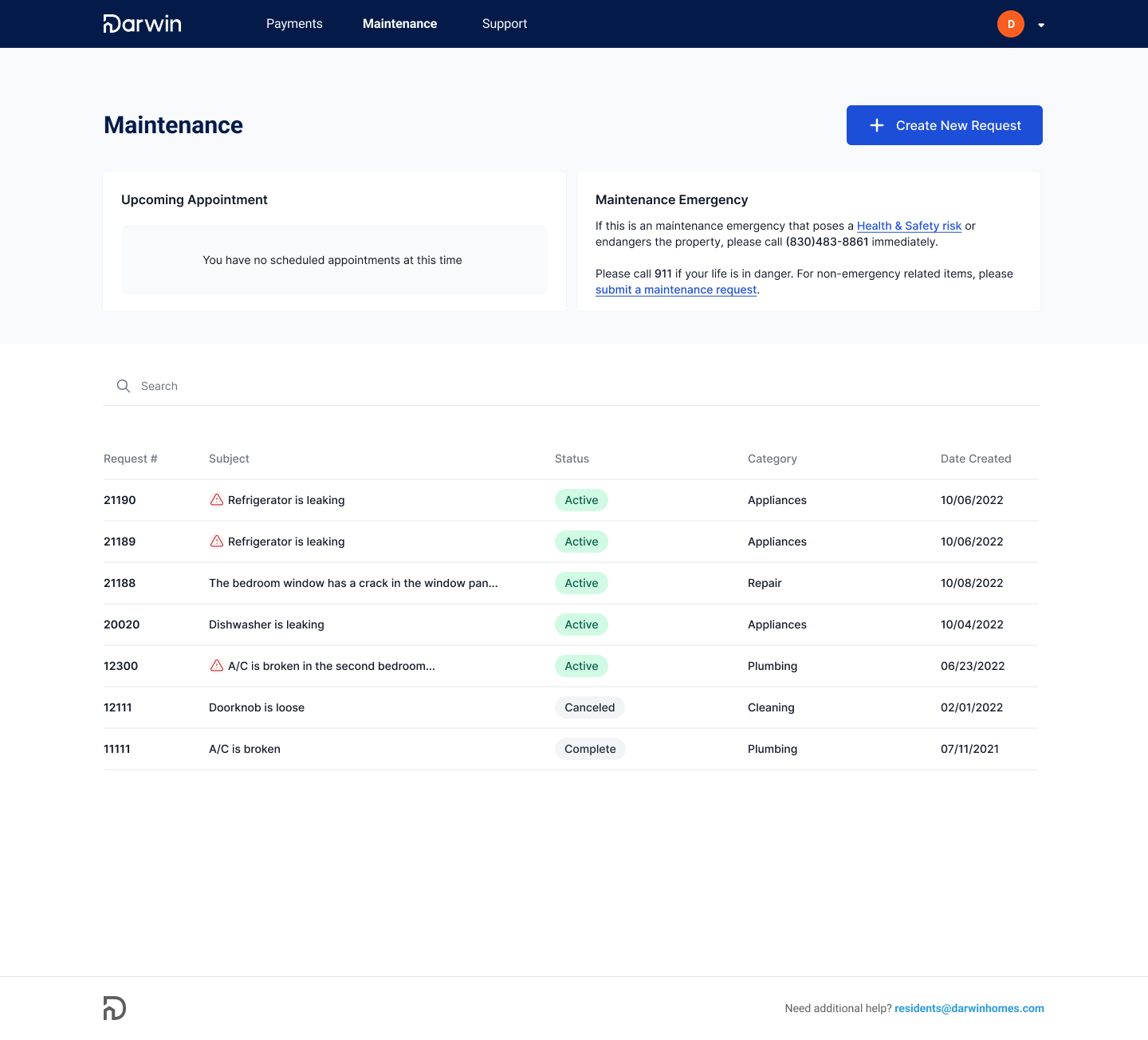
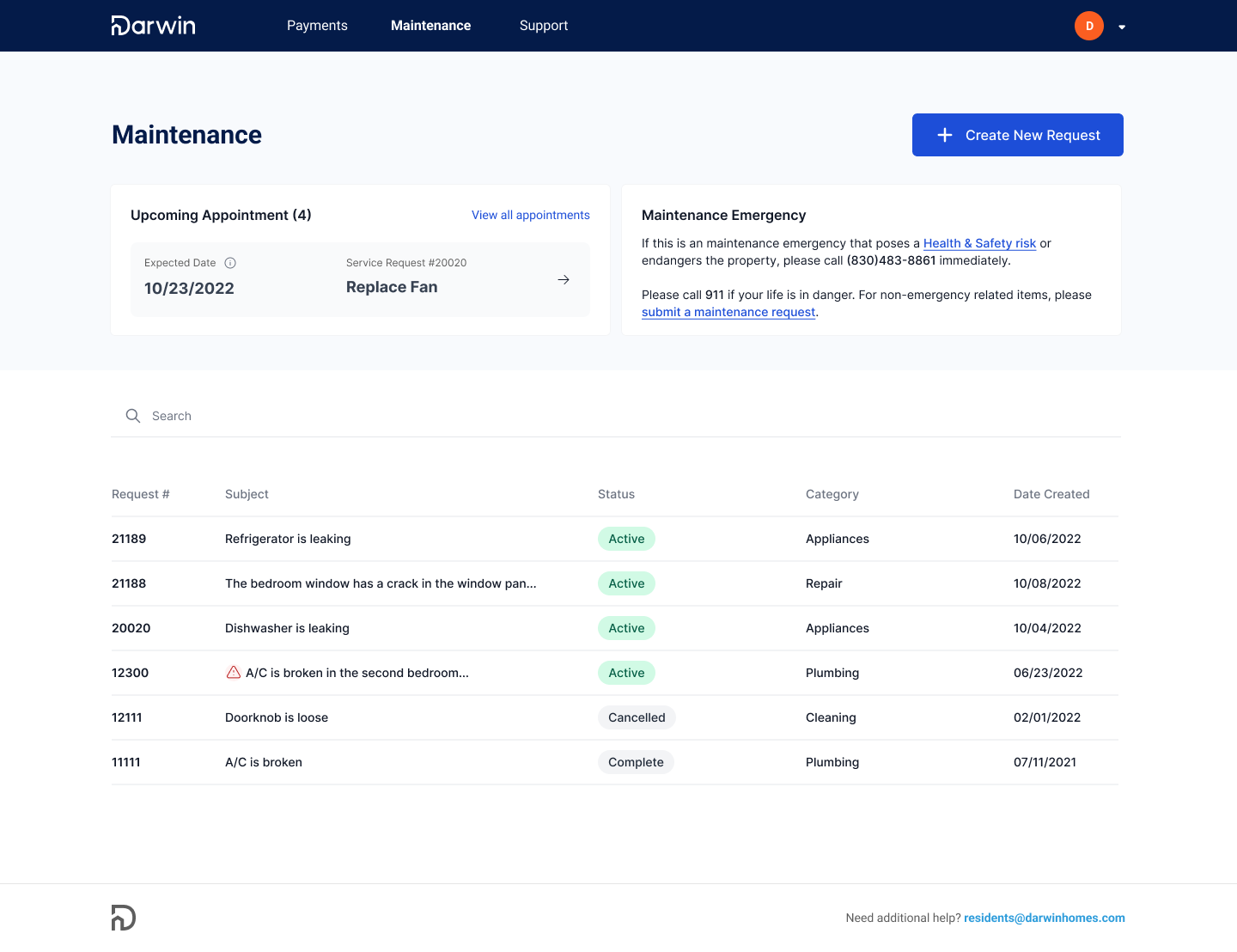

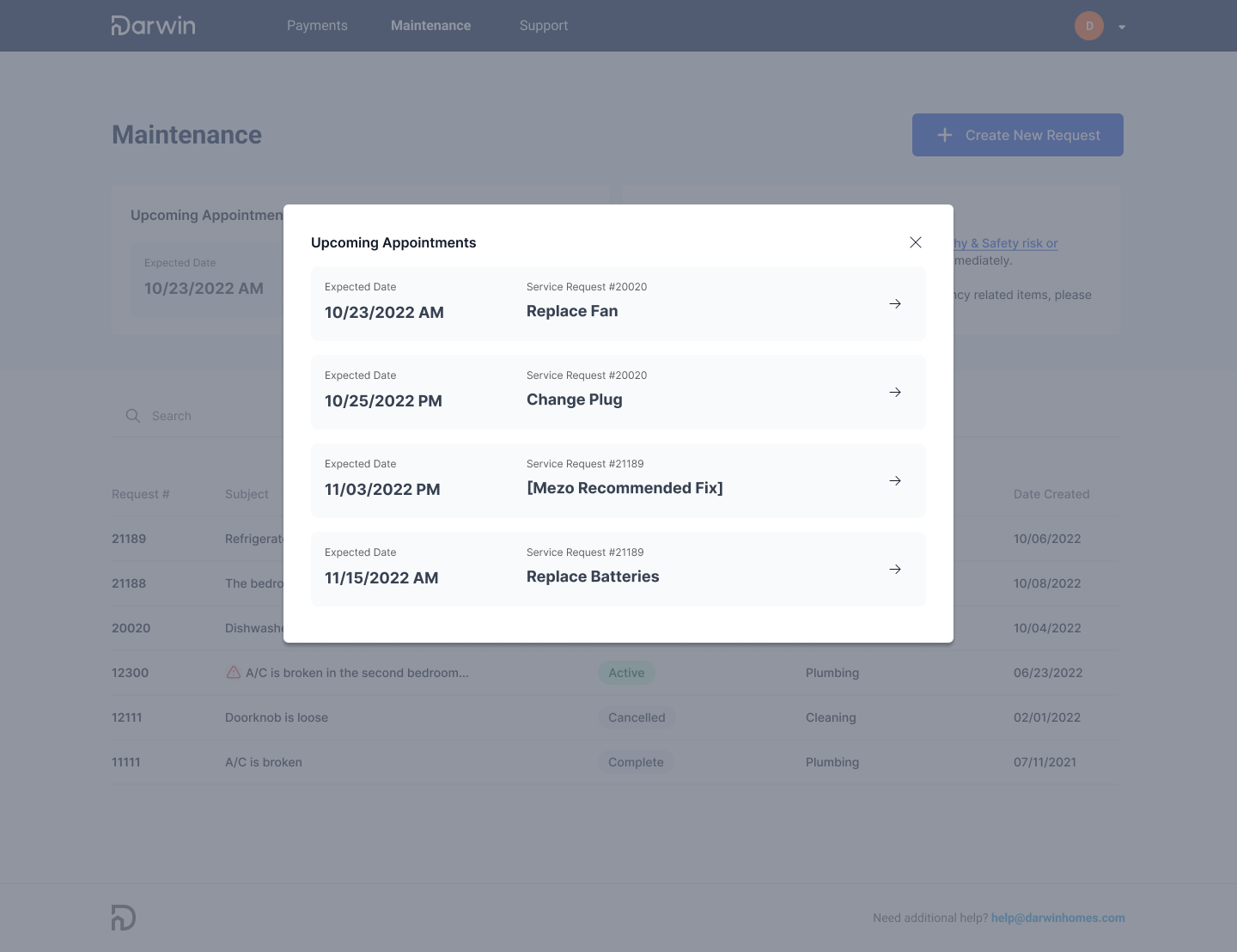
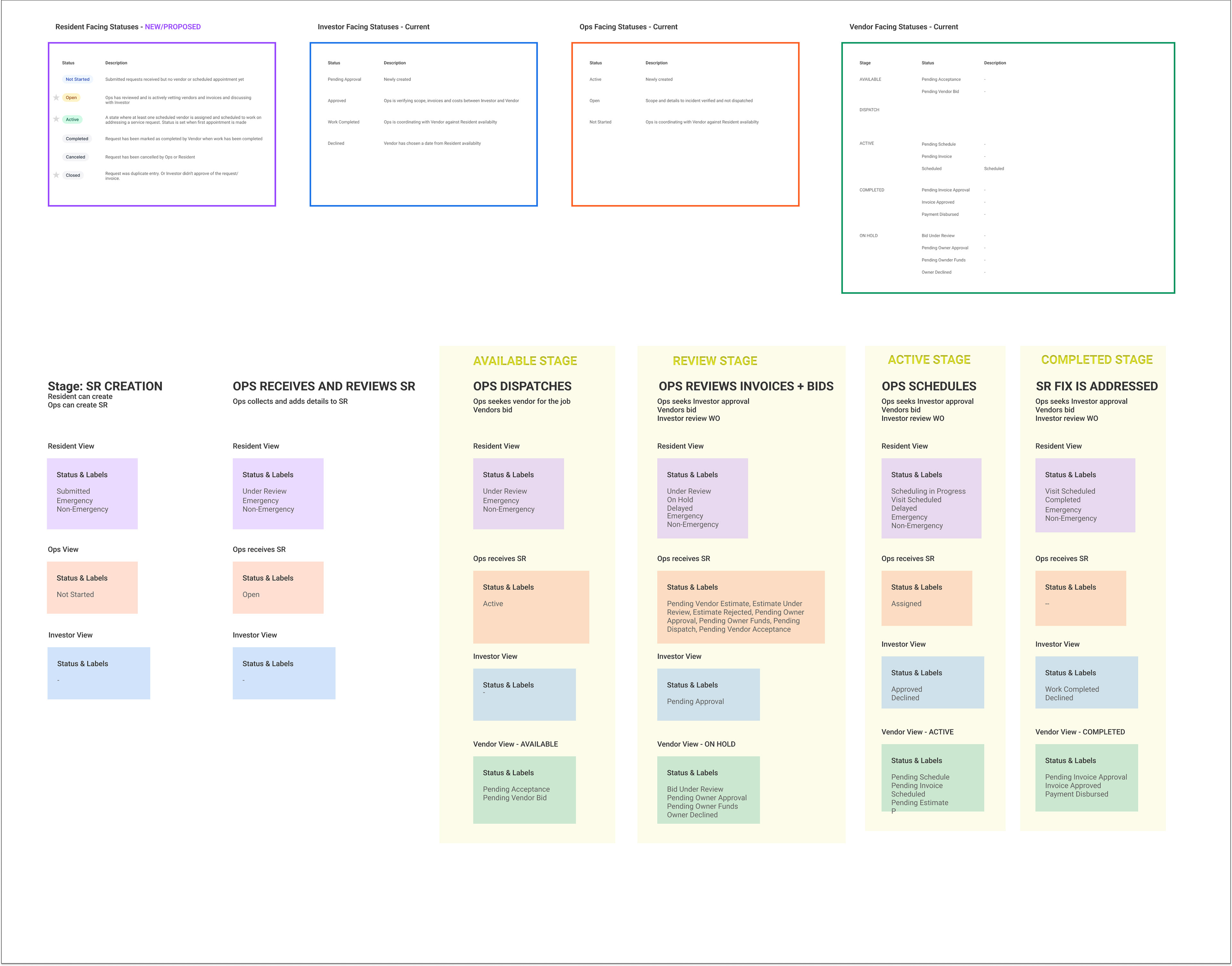
Delivered Designs - One Service Request with Single Work Orders
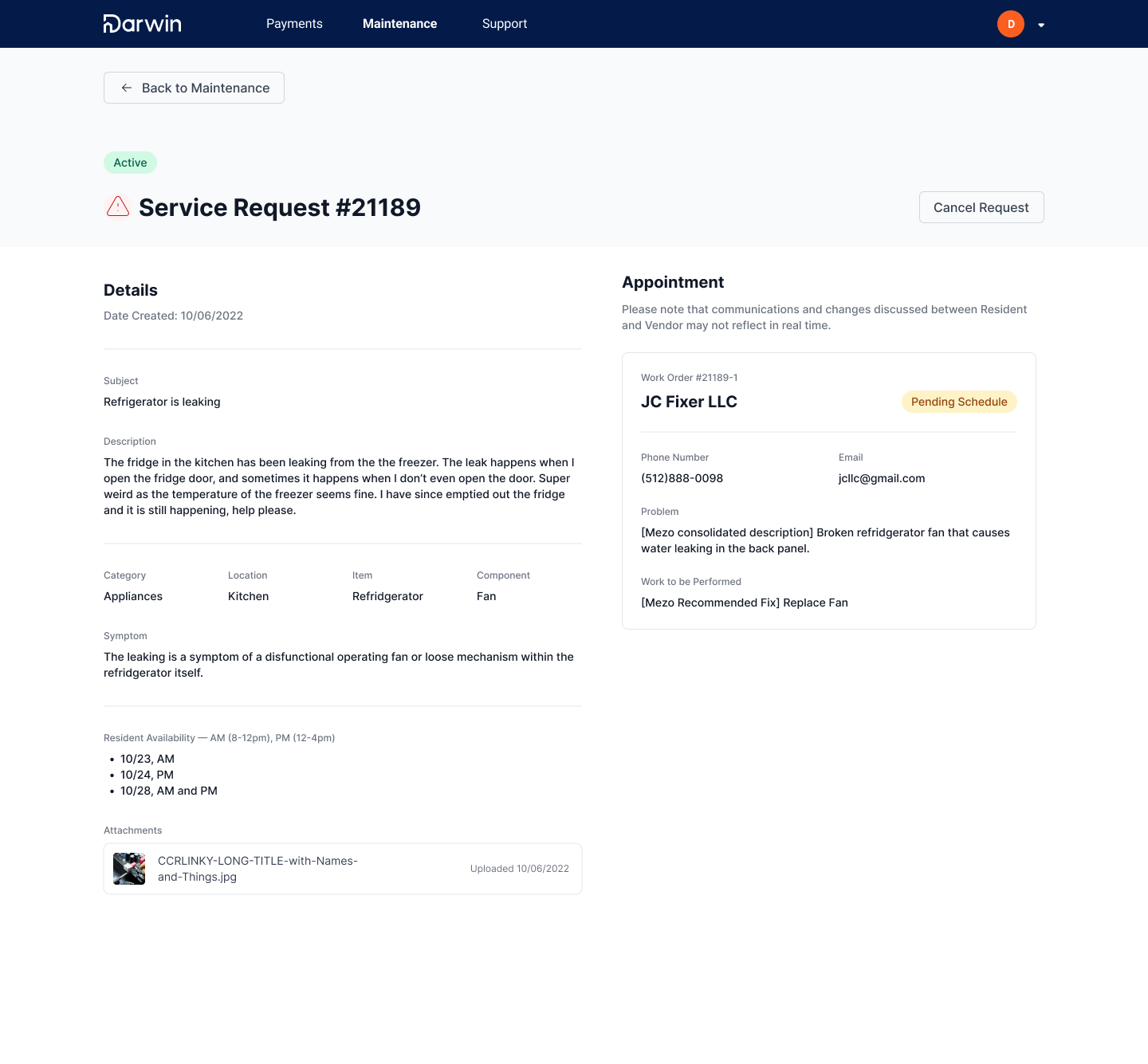
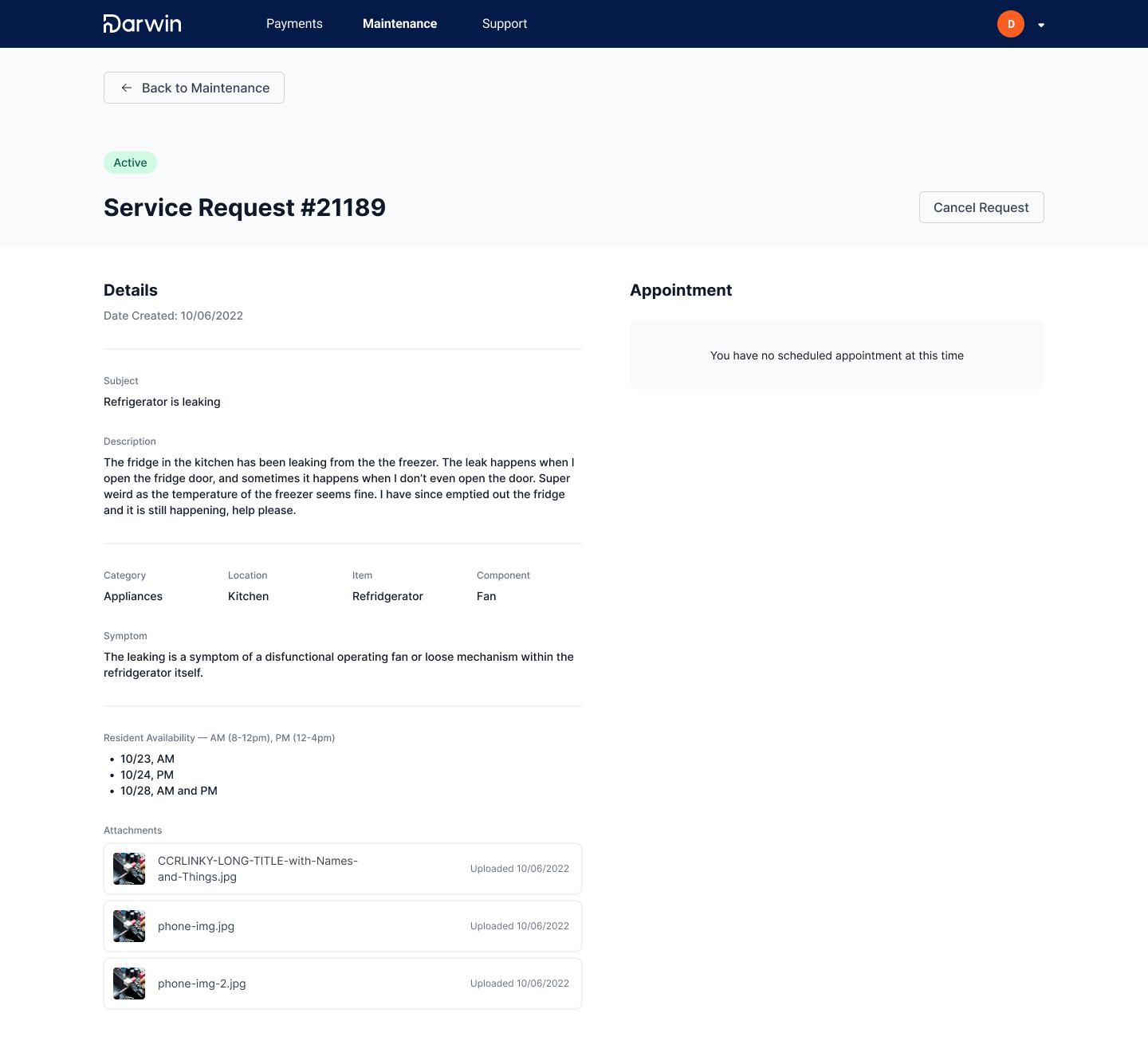
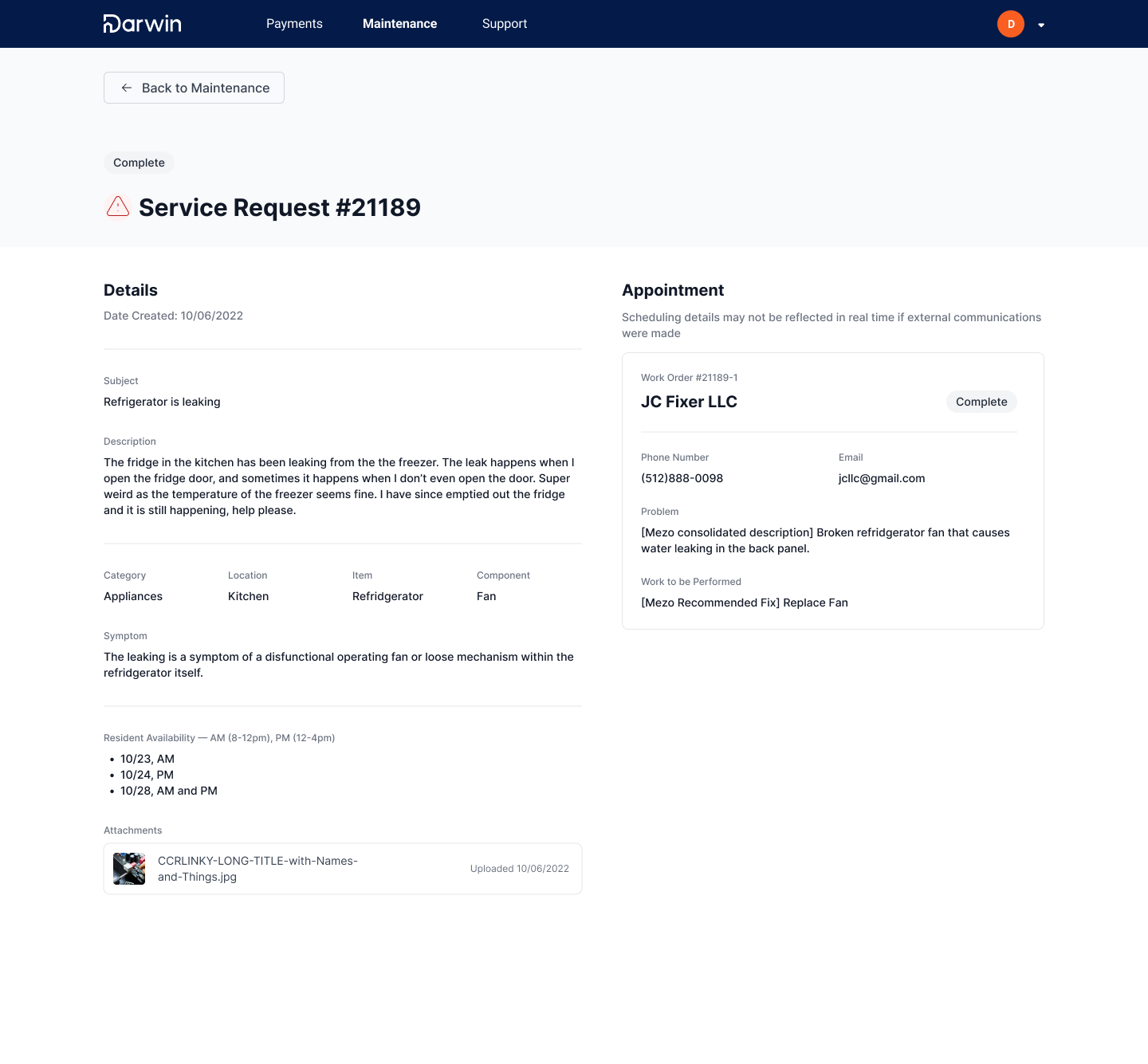
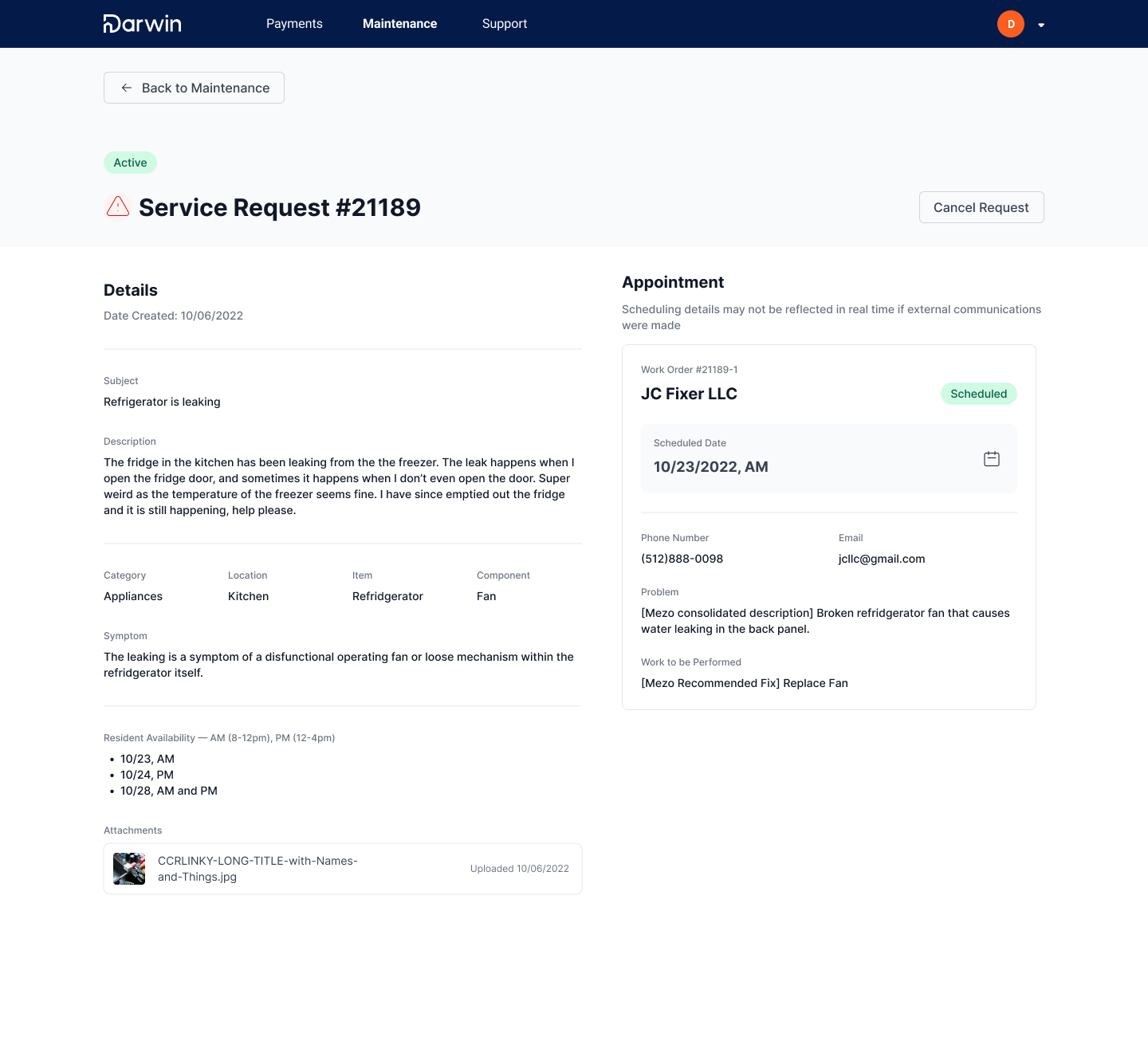
Delivered Designs - One Service Request with Multiple Work Orders
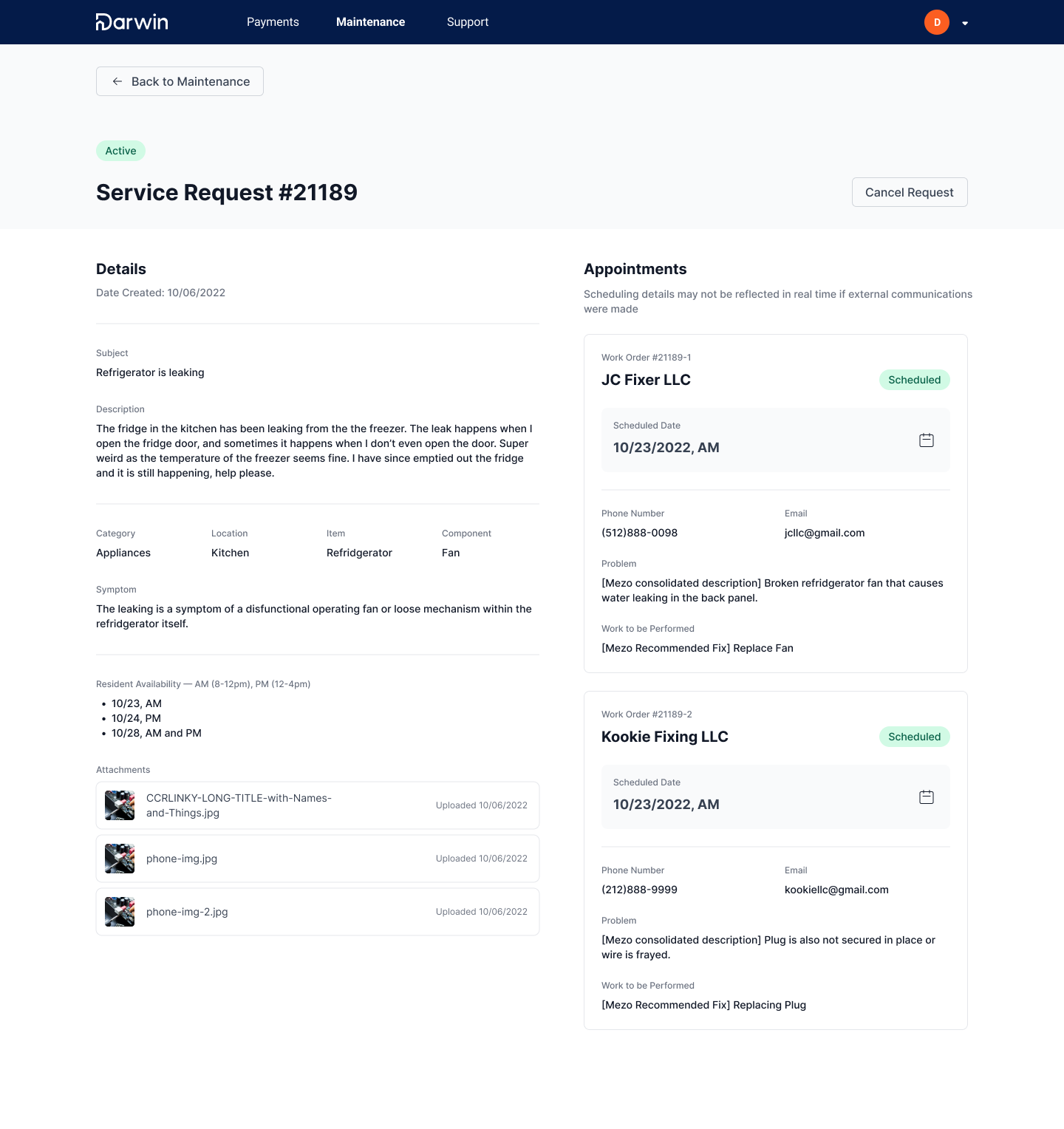
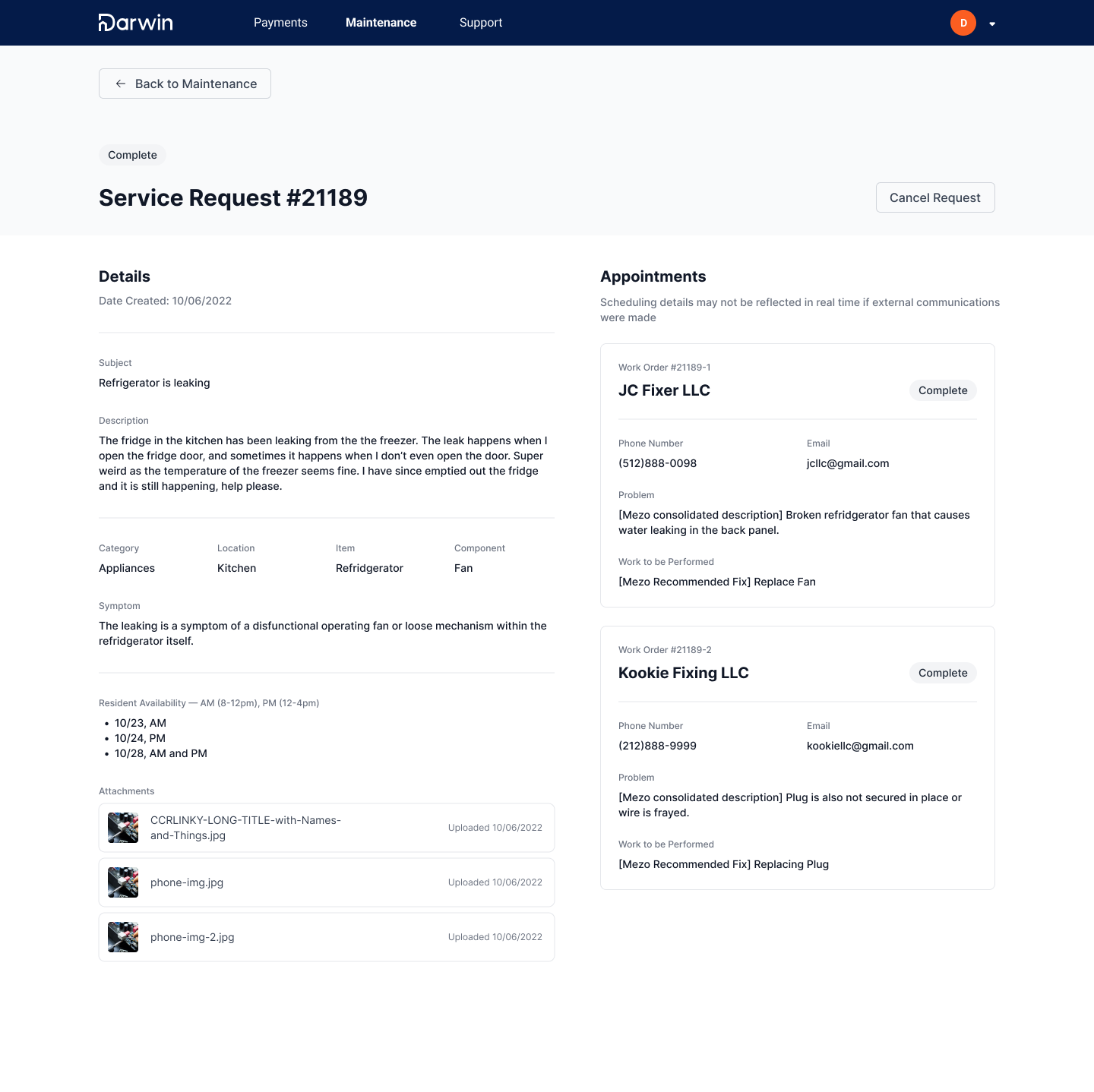
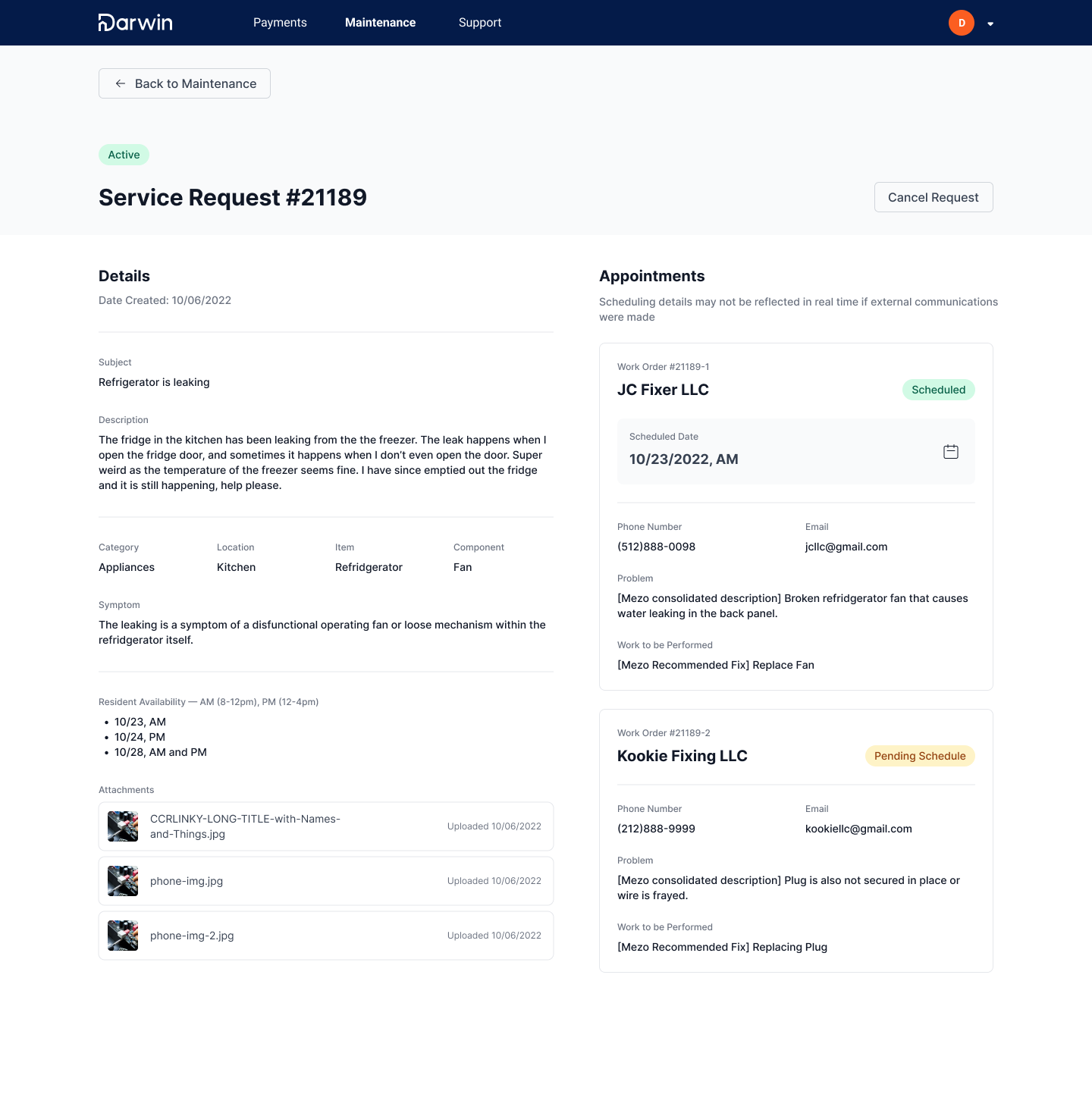
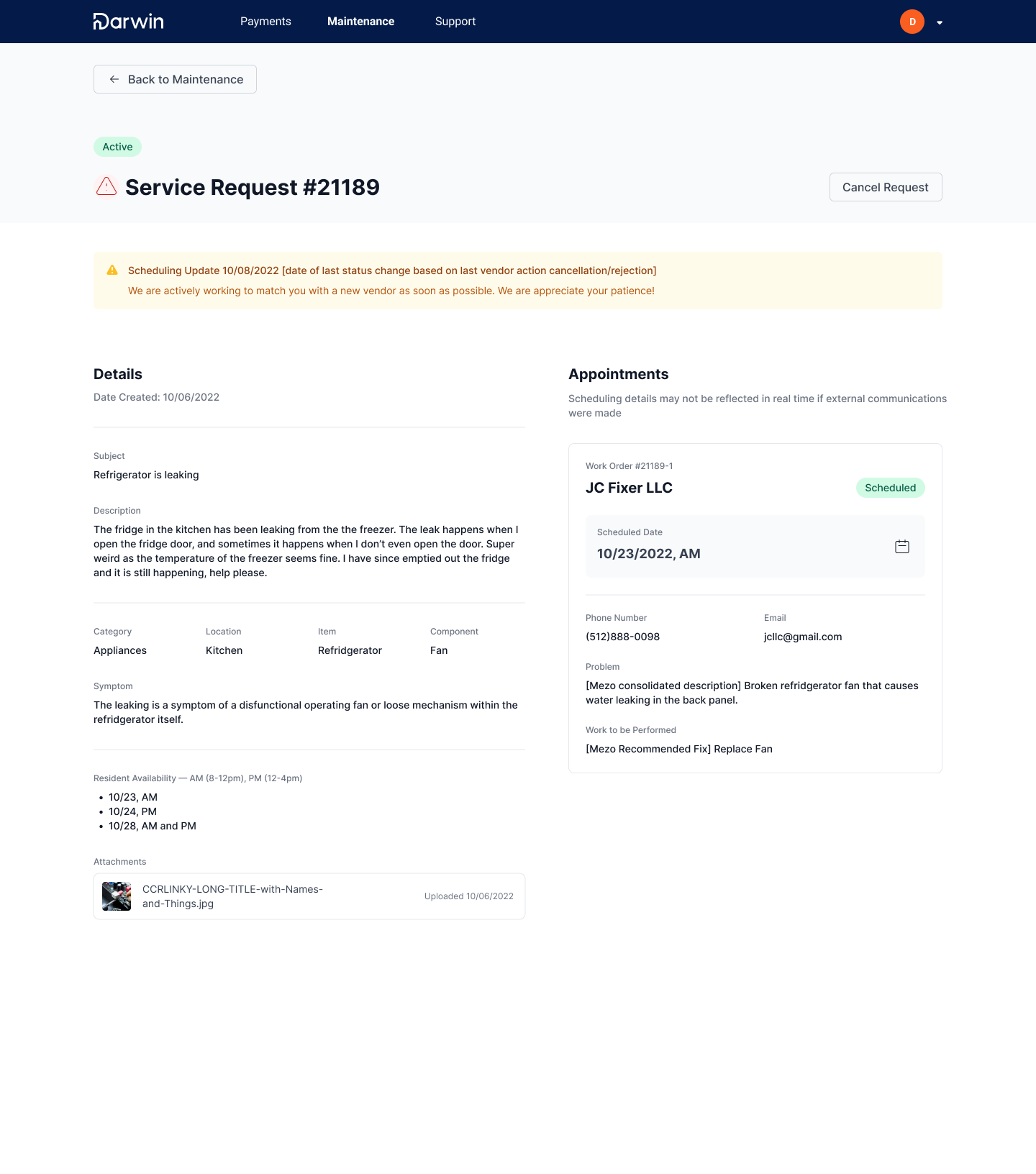
Delivered Designs - Service Request Detail Page - Canceled Before Work Order was Created

Revised Email Templates to Reflect Service Request and Work Order Transparency

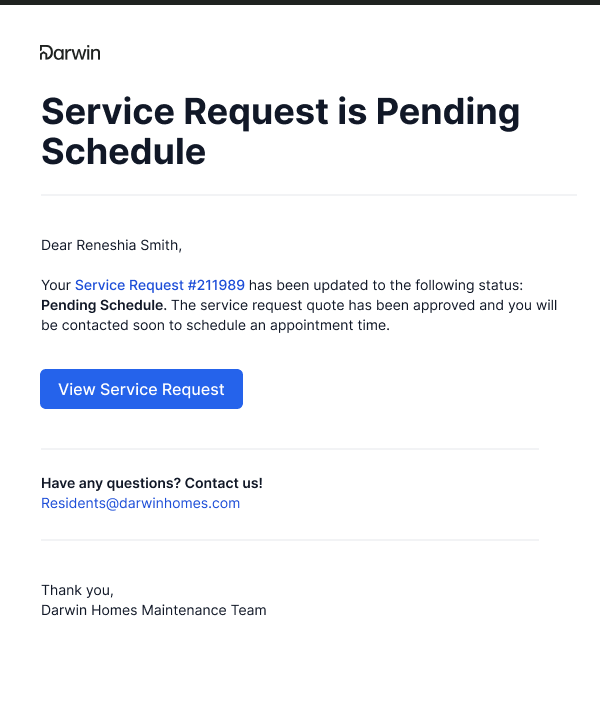
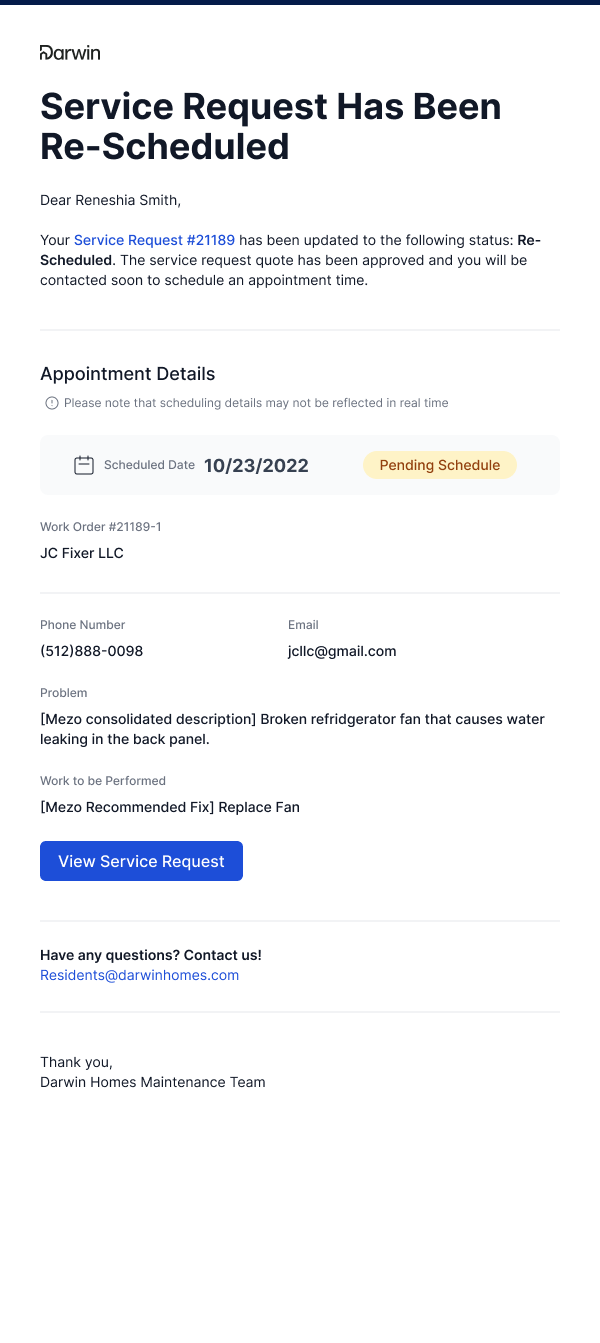

content Strategy and ia:
New resident facing Service Requests and Work Order Statuses
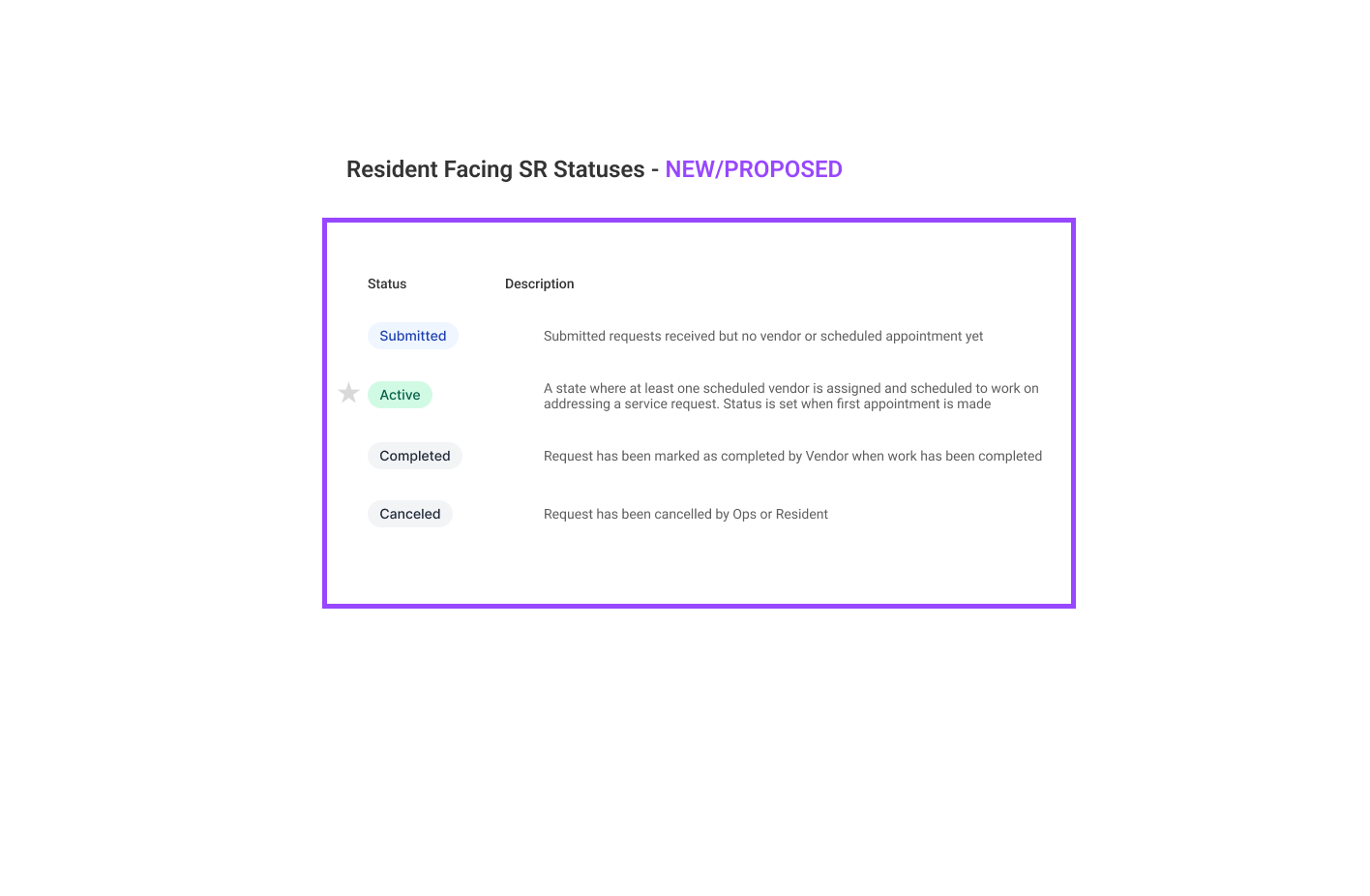
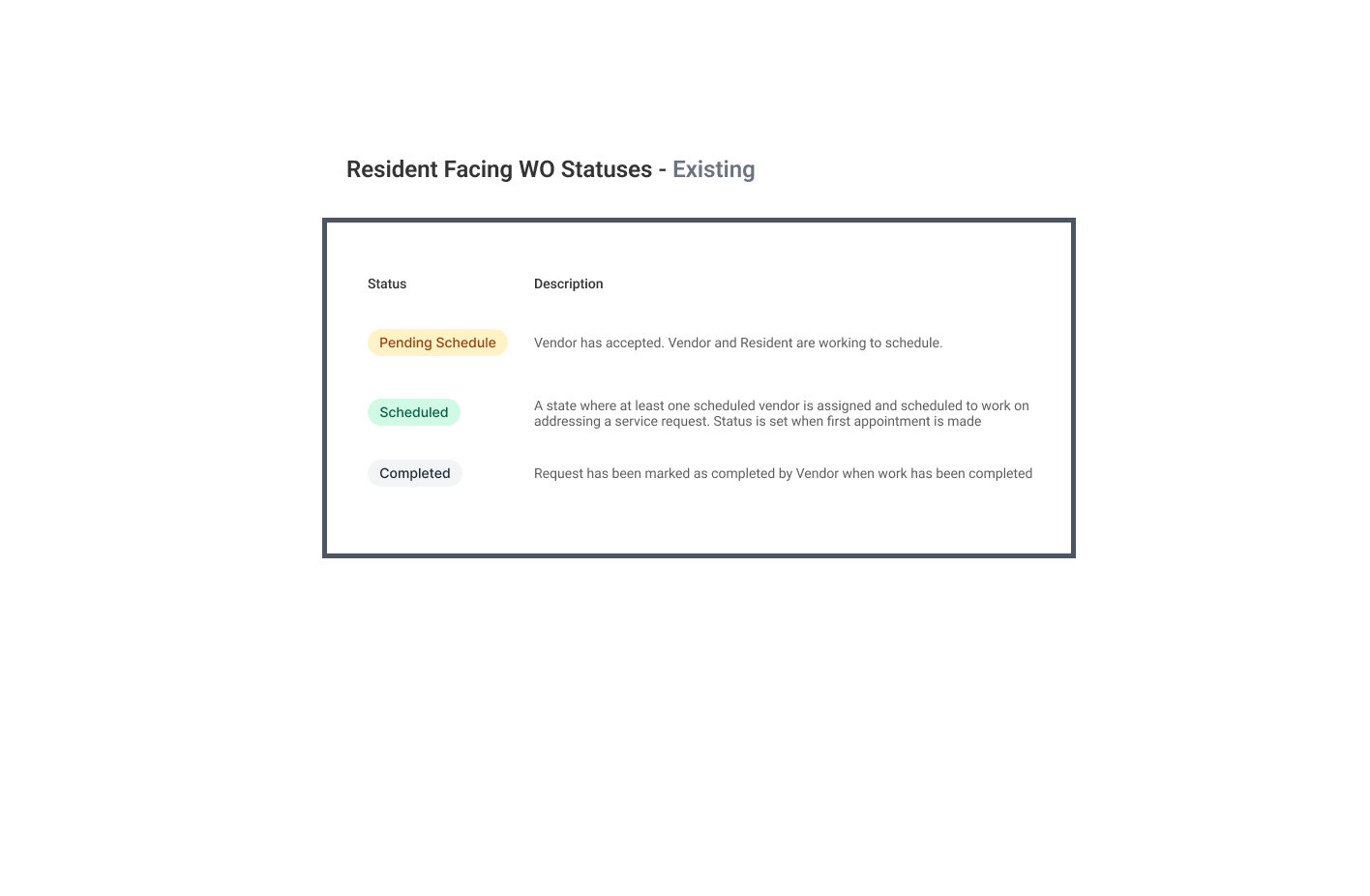
Artifact: Status Mapping // Credit: Me (Ana Peralta
The SR status are new and underwent through a few revisions to get the jargon correct. The WO statuses exist but were shaved down to only display the Residents the few that are relevant to me.
The SR status are new and underwent through a few revisions to get the jargon correct. The WO statuses exist but were shaved down to only display the Residents the few that are relevant to me.
Delivered Designs - Mobile
conclusions
Benefits of New Design
• Faster service request resolution time
• Improved retention/renewal rates
• Decreased cost from addressing fixes accurately (invoices) and efficiently (as close to one visit as possible)
• Better photo flow
• Documents resident availability and scheduling
• Gives Ops and Vendors the ability to label an emergency
• Exposes WO details and status to keep Resident in the loop
• Exposes assigned vendor details
• Showcases scheduled appointment
• Exposes a table on Resident Portal that records submitted Service requests as well as display Active and Closed Service Requests
• Includes Service Requests opened directly by Operators in Origin
• Includes Service Requests with recurring WOs
• Provides visibility into Residents when the next scheduled appointment is so they know that Darwin and Vendors are working closely to get their issue resolved asap
• New addition of resident-facing statuses: To ensure that the statuses we present on Resident Portal make sense while mapping them to Work Order statuses for consistency/automation
• Scale: Design can be applied to Service Requests with >1 Work orders
• Improved retention/renewal rates
• Decreased cost from addressing fixes accurately (invoices) and efficiently (as close to one visit as possible)
• Better photo flow
• Documents resident availability and scheduling
• Gives Ops and Vendors the ability to label an emergency
• Exposes WO details and status to keep Resident in the loop
• Exposes assigned vendor details
• Showcases scheduled appointment
• Exposes a table on Resident Portal that records submitted Service requests as well as display Active and Closed Service Requests
• Includes Service Requests opened directly by Operators in Origin
• Includes Service Requests with recurring WOs
• Provides visibility into Residents when the next scheduled appointment is so they know that Darwin and Vendors are working closely to get their issue resolved asap
• New addition of resident-facing statuses: To ensure that the statuses we present on Resident Portal make sense while mapping them to Work Order statuses for consistency/automation
• Scale: Design can be applied to Service Requests with >1 Work orders
results and achievements
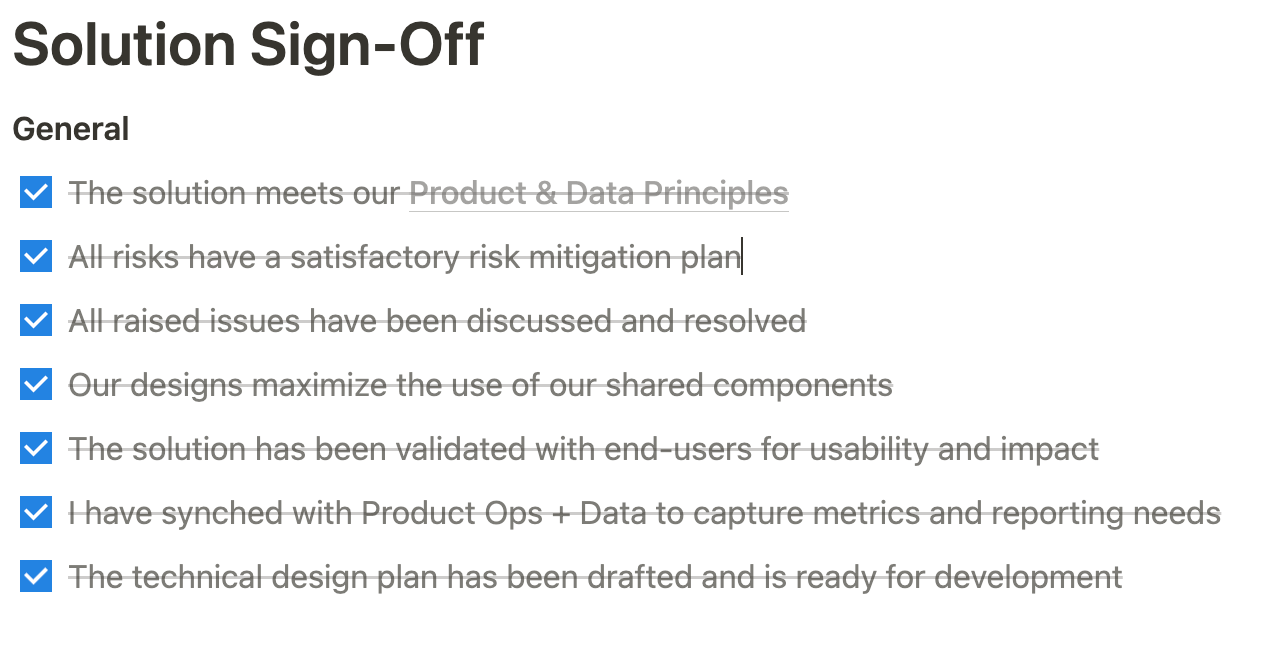
Qualitative and Quantitative data on the results of the project: TBD
